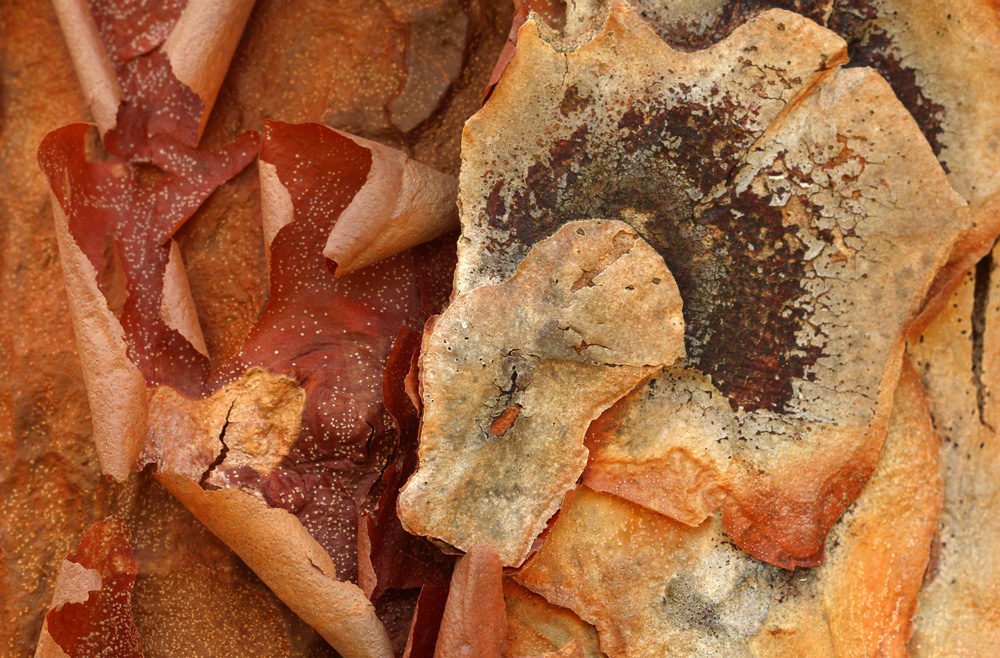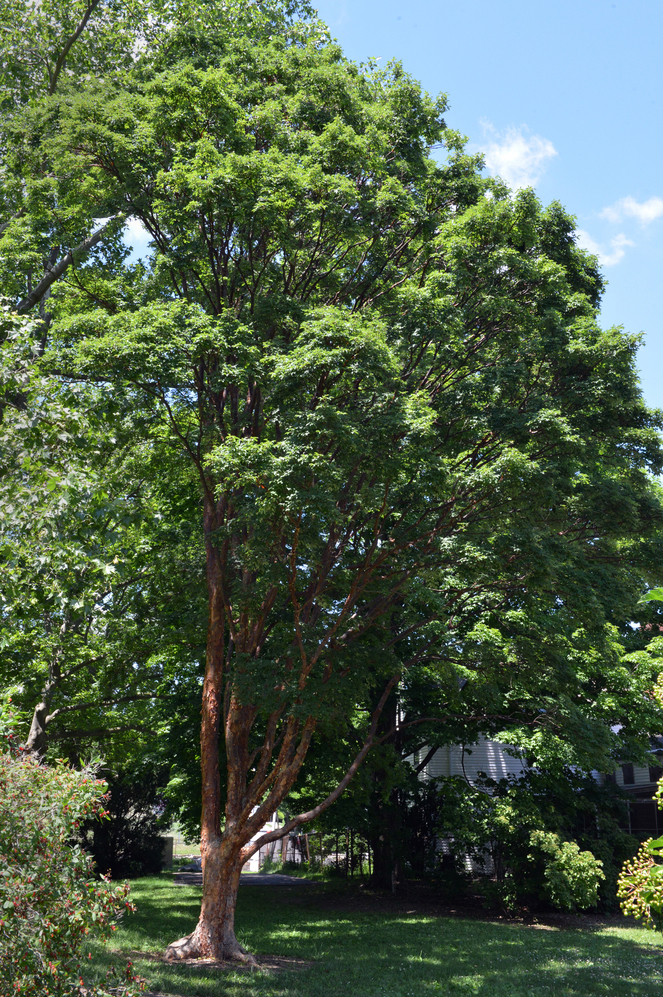1
Paperbark Maple
Acer griseum
CHINA – NACPEC ’94 WD172
NACPEC HUBEI EXPD. ’94
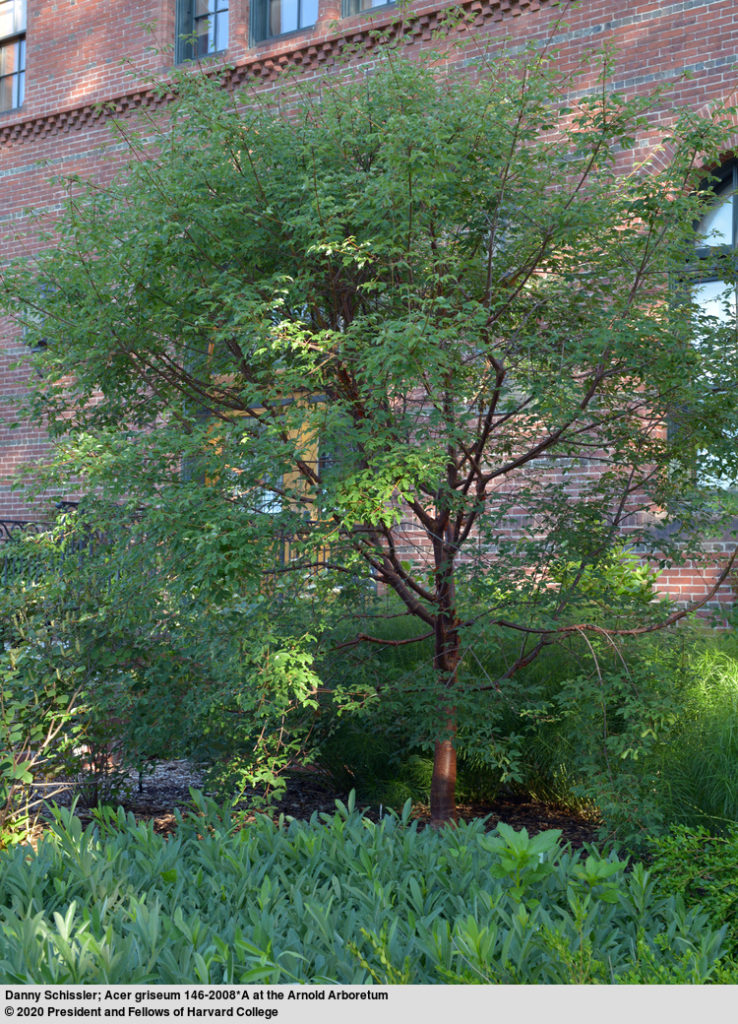
-
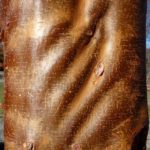
Copper-colored bark. -
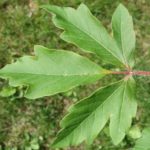
Compound leaves with three leaflets. -
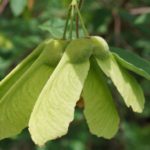
Winged seeds, known as samaras.
The Arnold Arboretum is a place where storied plants gather.
From the steps of the Hunnewell Building, to as far as you can see, grows a myriad of plants, living museum specimens, each with a unique story to tell. Interplay of plant and story, of object and information, is central to the Arboretum’s mission. As Keeper of the Living Collections, I am charged with stewarding this assembly of plants, collections of lore. On this tour, I’ll share stories of just a few of the plants that make up the Arnold Arboretum’s legacy.
Not far away grows a paperbark maple (Acer griseum) from the mountains of China, with its coppery bark flaking like cinnamon. It may be rare in nature, but is common to horticulture. The tree is surrounded by a mass of the herbaceous bluestar (Amsonia hubrechtii) that I collected in Arkansas in 2014. This bundle of feathery leaves gleam yellow in autumn, though the soft blue springtime blooms give it its common name. There is also ‘Gus Melquist’, a ground covering sand cherry (Prunus depressa) the Arboretum introduced to horticulture because the white carpet of spring flowers and fiery red autumn leaves should grace any garden. Viburnums and witchalders, magnolias and more maples also grow nearby. Each is a testament to its origin, or provenance, as well as its potential to inspire in this Arboretum landscape.
Want to dig deeper?
Explore the Paperbark Maple Plant Bio


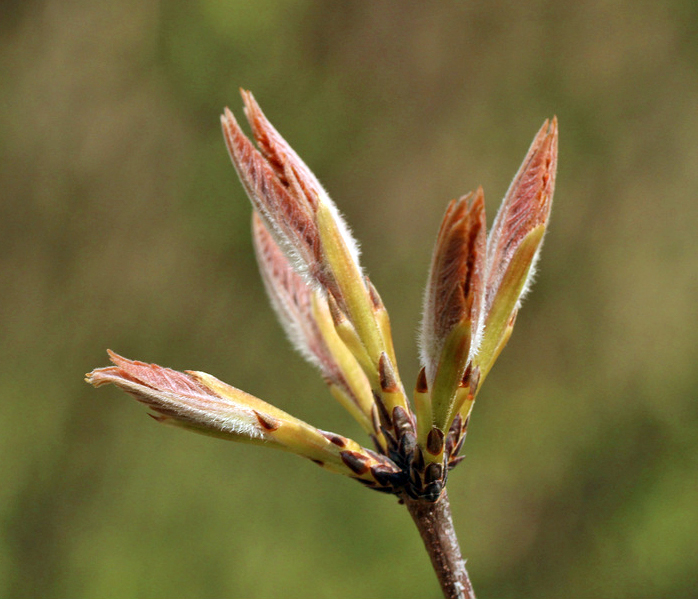

2
Mongolian Linden
Tilia mongolica
AIELLO, A. S., DOSMANN, M.,
WANG, K. NACPEC10-036
NACPEC SHAANXI, HEBEI, AND BEIJING PLANT EXPED. TRIP 2010
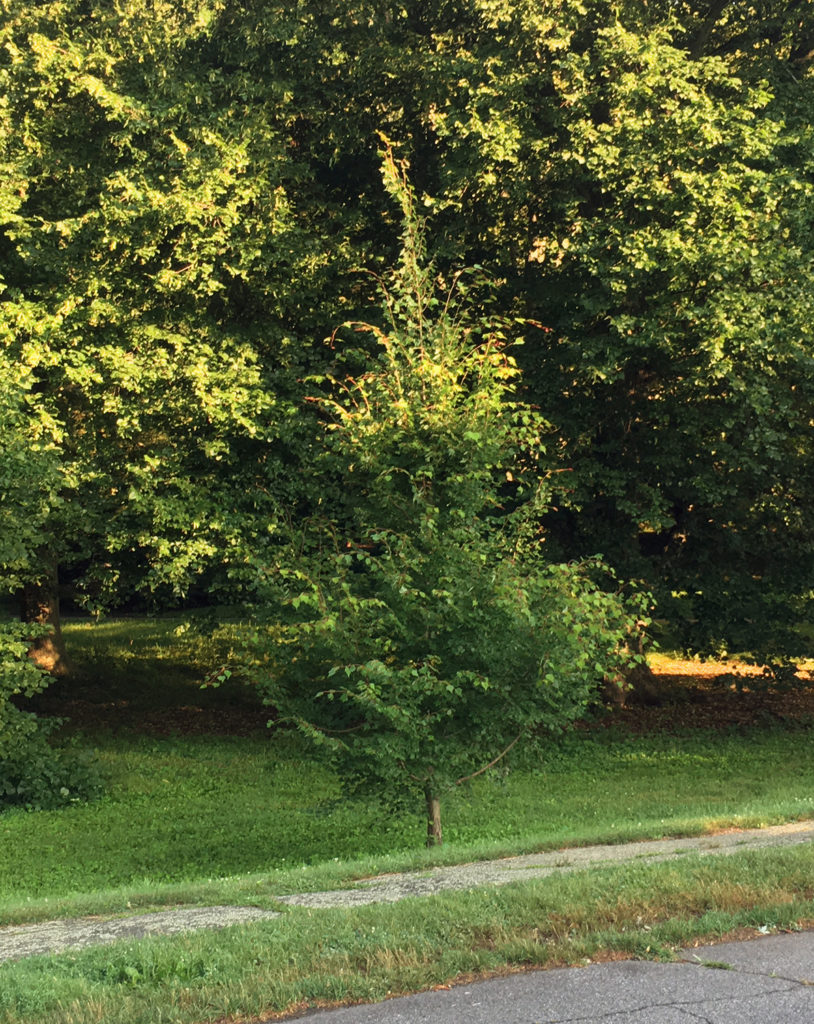
-
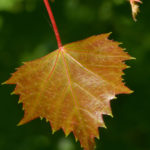
Newly emerged leaf with reddish hue. -
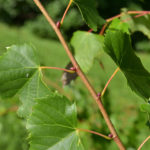
Heart-shaped leaves along young stem. -
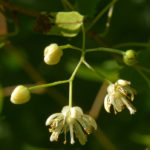
Small white flowers and flower buds.
Even old, established collections experience change and new plantings.
This spot illustrates that the Arboretum always changes, how in a timeworn linden collection, old trees give way to new. Sometimes, a storm topples a tree, and in other instances we remove because a replacement at the ready is of greater value, has a new story to tell. This Mongolian linden (Tilia mongolica), planted in 2016, grew from seed I collected with colleagues on a NACPEC (North America China Plant Exploration Consortium) expedition to Hebei, China. Already, it shows great promise to become an attractive and vigorous landscape tree, bearing bright golden-yellow autumn leaves. It also has a wealth of data we collected in the field that hot, dry day in 2010: photographs of the mother plant, the site’s coordinates and elevation, type of habitat and soil, even a list of nearby plant species. Judging by its growth rate, this tree will soon look like it has always been here.

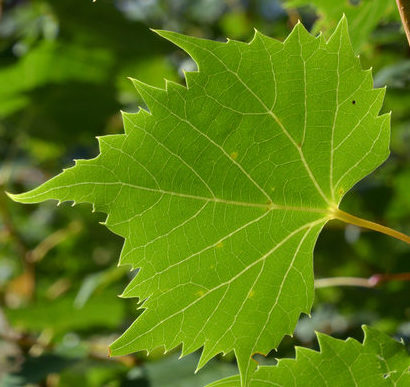
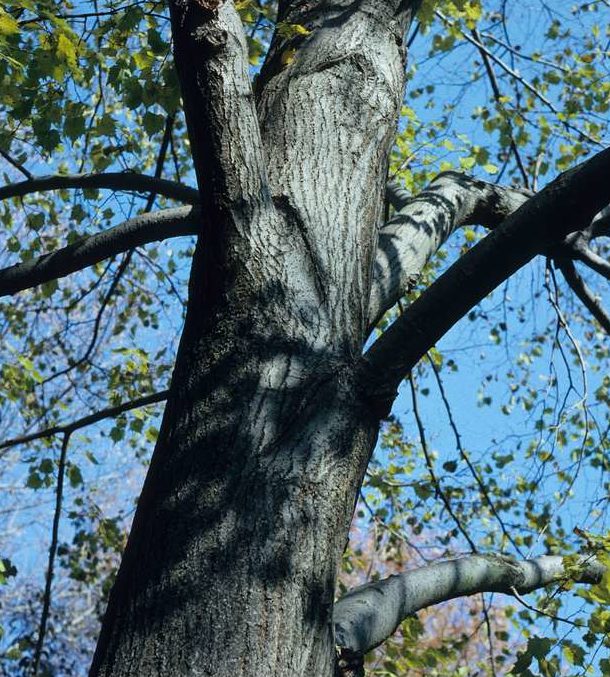
3
Forked Viburnum
Viburnum furcatum
WILSON, E. H. 7093
E. H. WILSON, ARNOLD ARB.
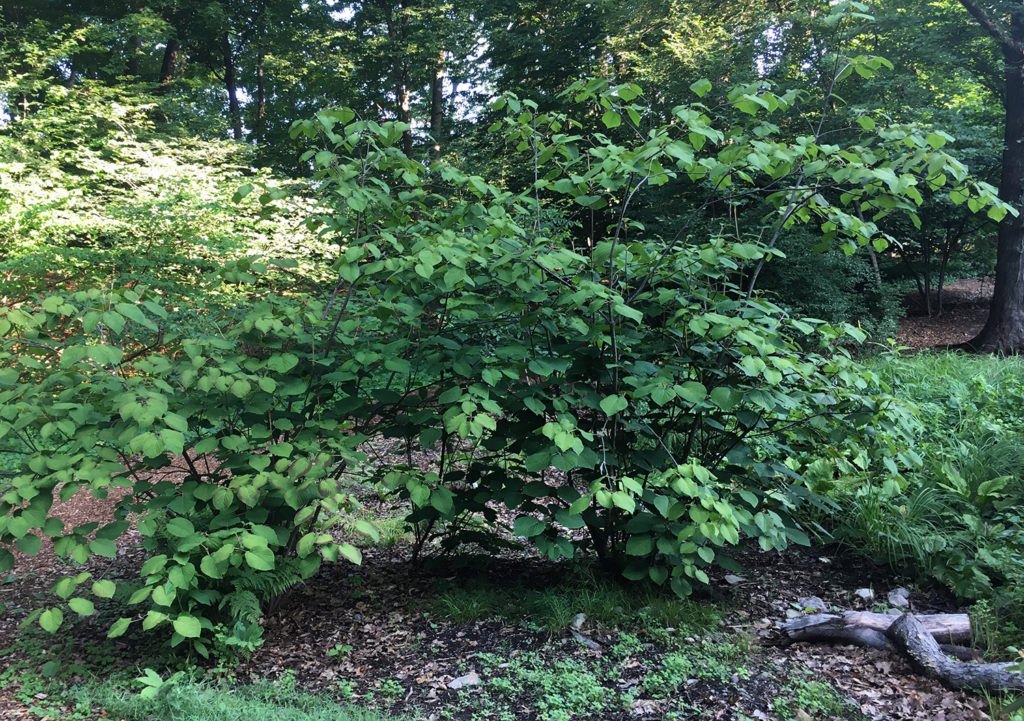
-
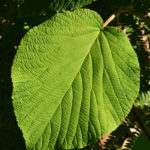
Large simple leaf. -
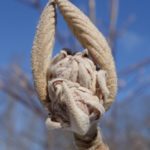
Scale-less dormant bud in winter. -
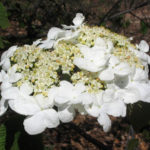
Large disc-shaped white flower.
The Arboretum is one big family reunion.
In this area we grow species that require moist soil conditions, including this trio of forked viburnum (Viburnum furcatum) collected by Ernest Wilson in Japan a century ago. Their large, rounded leaves and early spring clusters of white flowers are strikingly like the hobblebush (Viburnum lantanoides), native to the eastern part of North America. In fact, on either side of the Japanese species we’ve planted several of its American cousin. Can you tell them apart? Their close relatedness is an example of one of the richest stories at the Arboretum, that of biogeography or the study of how species (particularly closely related ones) are now distributed across the globe. In the Arboretum, a cultivated family reunion, cousins from a hemisphere away now grow side-by-side. We not only can share stories about them, but also learn more – write new stories if you will – about their biology through research.
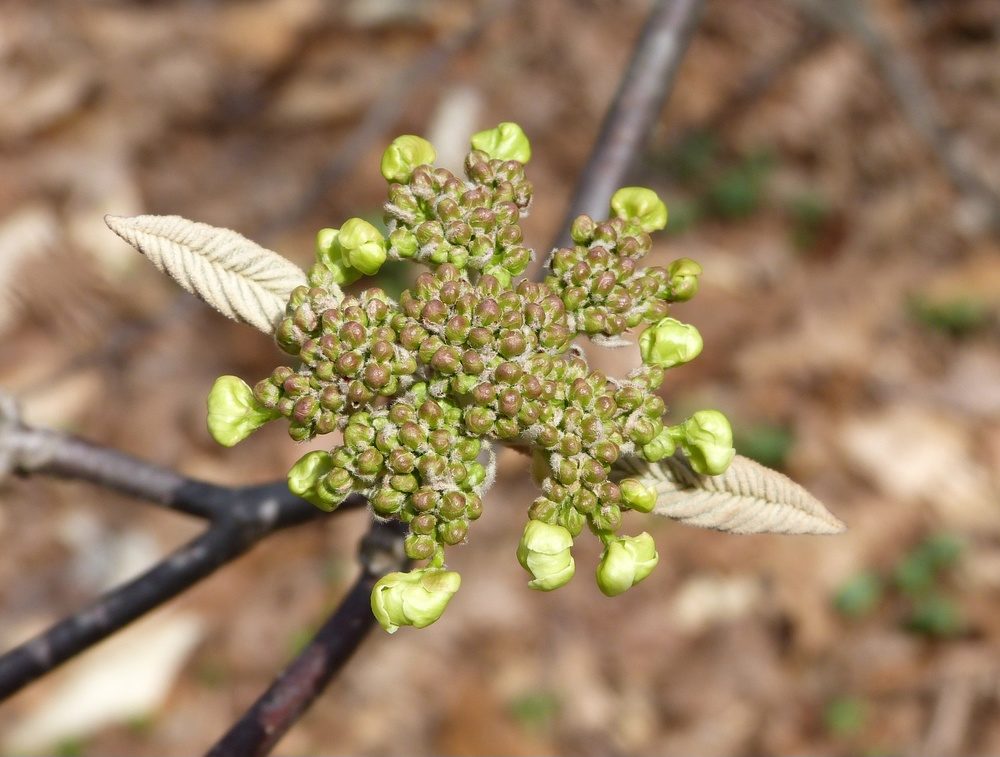
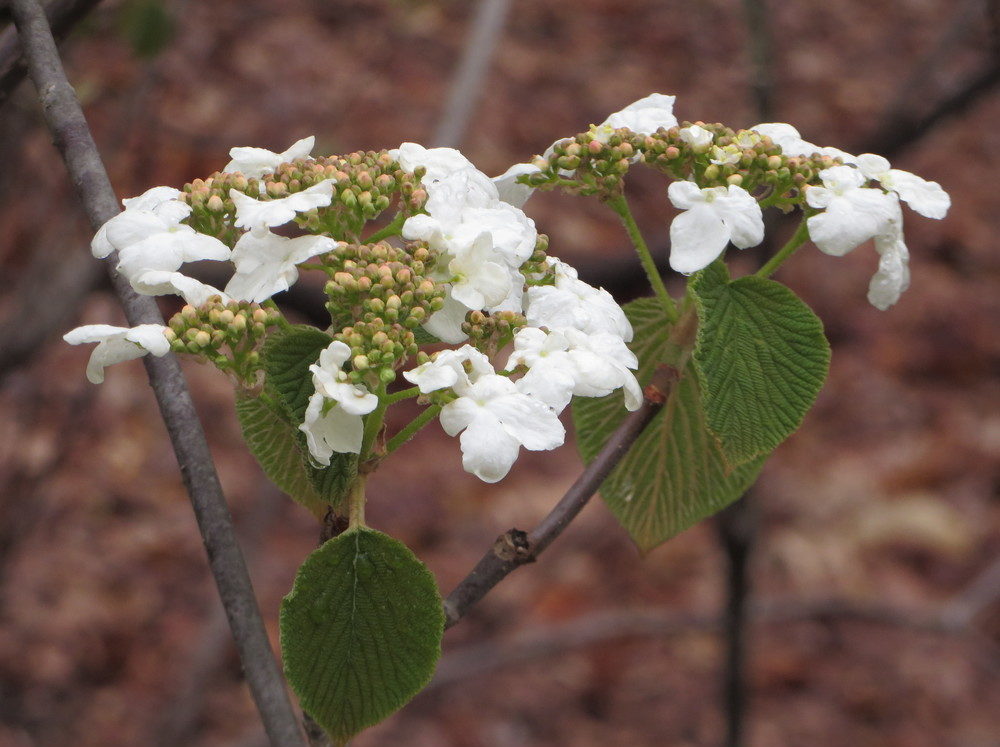
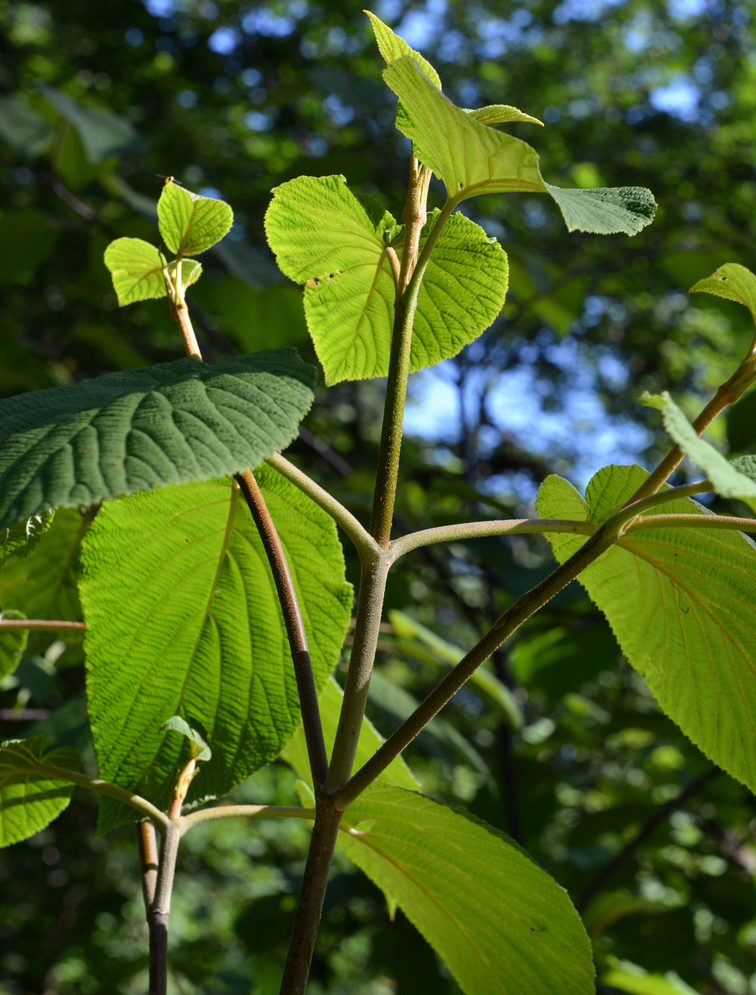
4
Paperbark Filbert
Corylus fargesii
LEWANDOWSKI, R., CONRAD,
K., AULT, J., KIM, K., CUI, T. QLG231
MORRIS ARBORETUM, PA
ORIG FROM NACPEC SHAANXI EXPD. ’96
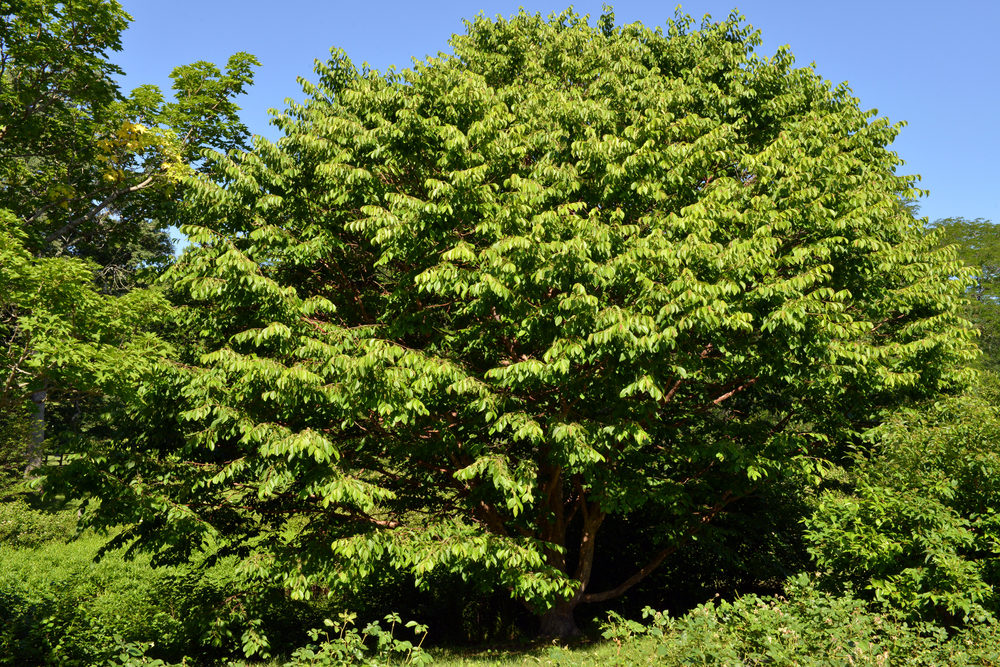
-
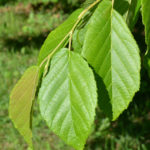
Simple leaves with serrated edges. -
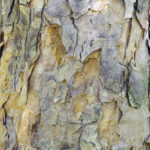
Pale flaking bark. -
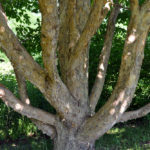
Mature multi-stemmed trunk.
A new garden tree from the wild.
Nature possesses rich diversity with new things to learn around every bend, like finding plants of merit for the garden or managed landscape. This paperbark filbert (Corylus fargesii) is a tree recently brought into cultivation in North America, collected first in 1996 in China by colleagues representing NACPEC who shared seedlings with the Arboretum (including this one). The species has many attributes, and I am particularly drawn to its upright-to-pyramidal form and beautiful flaking bark. After several decades of horticultural evaluation by NACPEC, and distribution to nurseries, it is now finding its way into the home landscape. The filbert was collected on two additional NACPEC expeditions, including one I was on in 2015. I cannot wait to see how trees from all three trips perform in the Arboretum collections in the years to come.
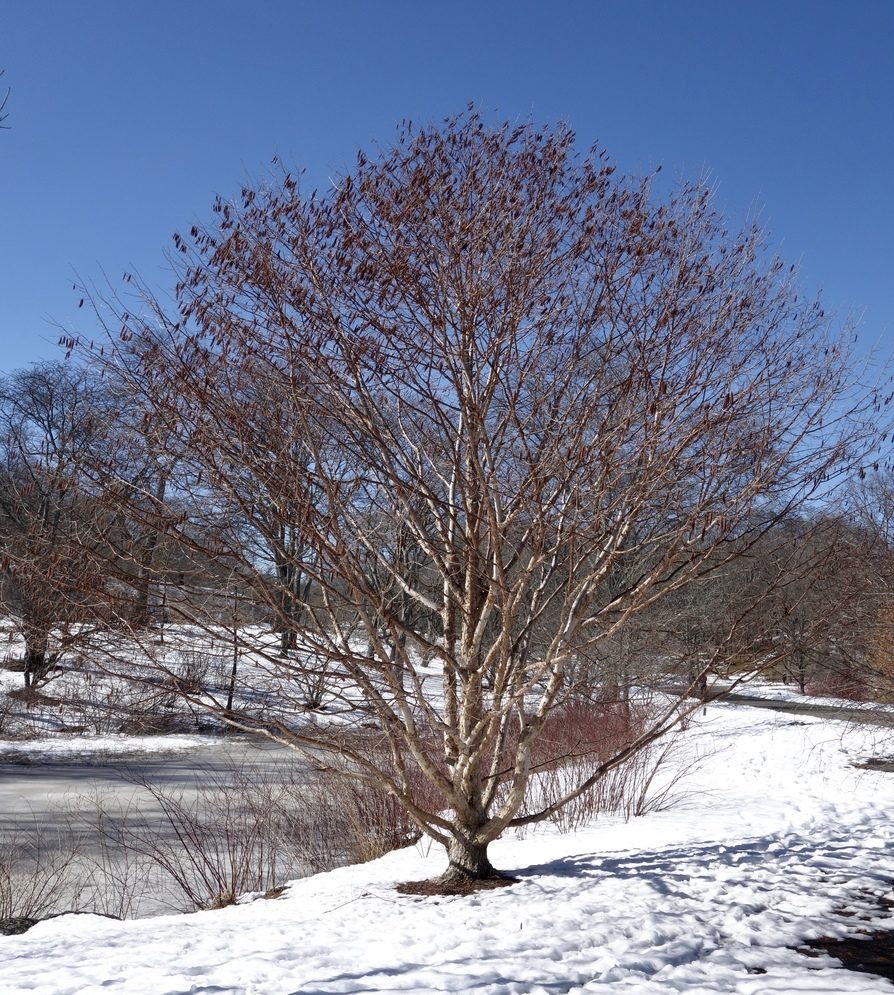
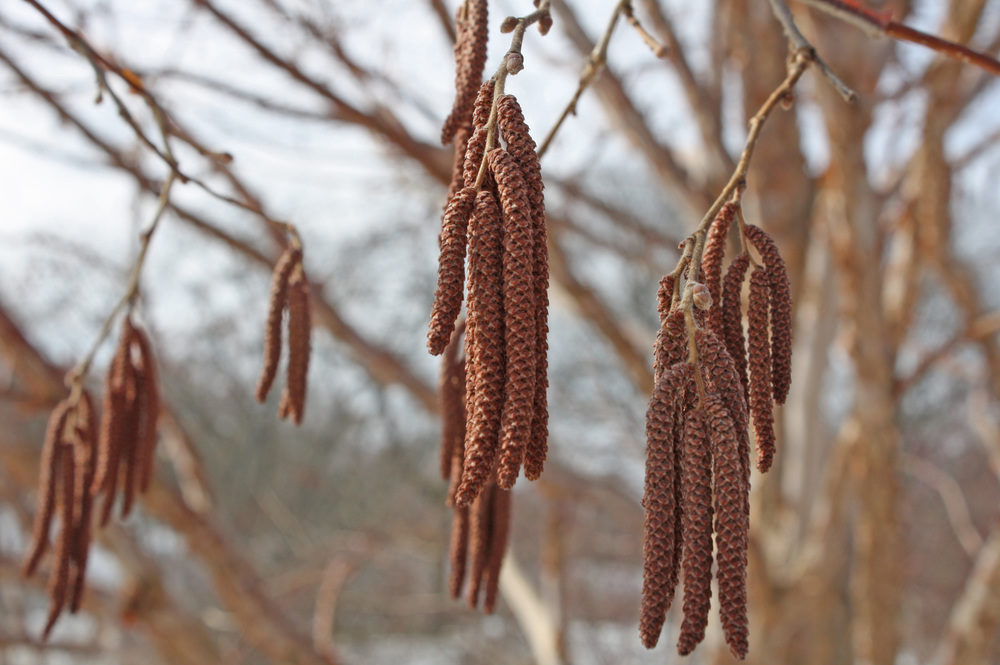
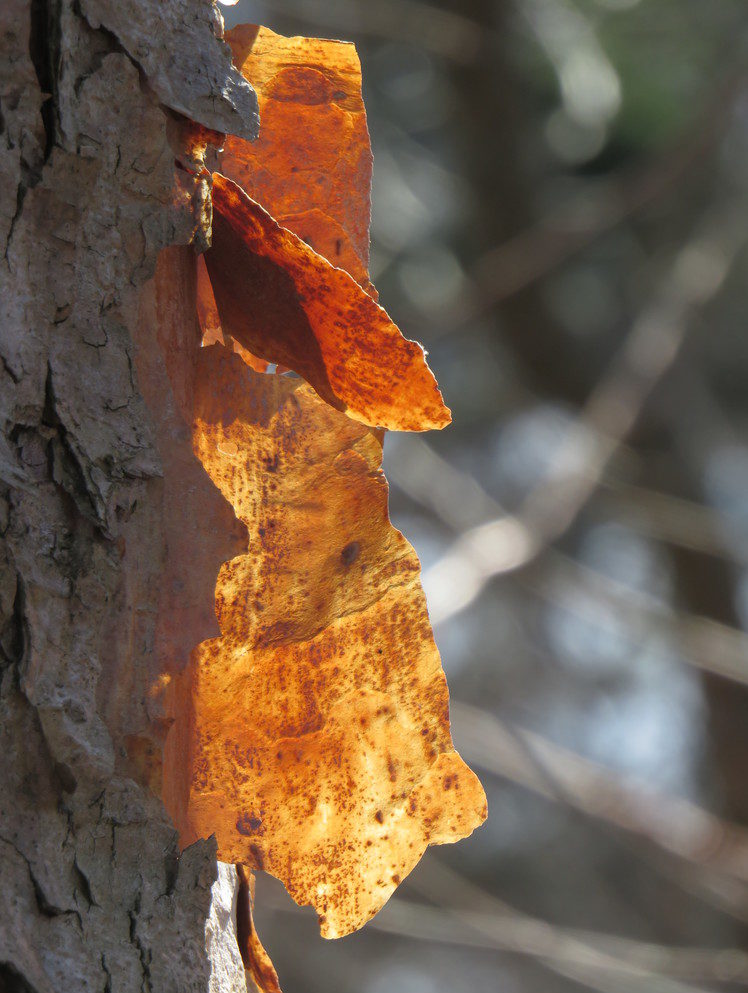
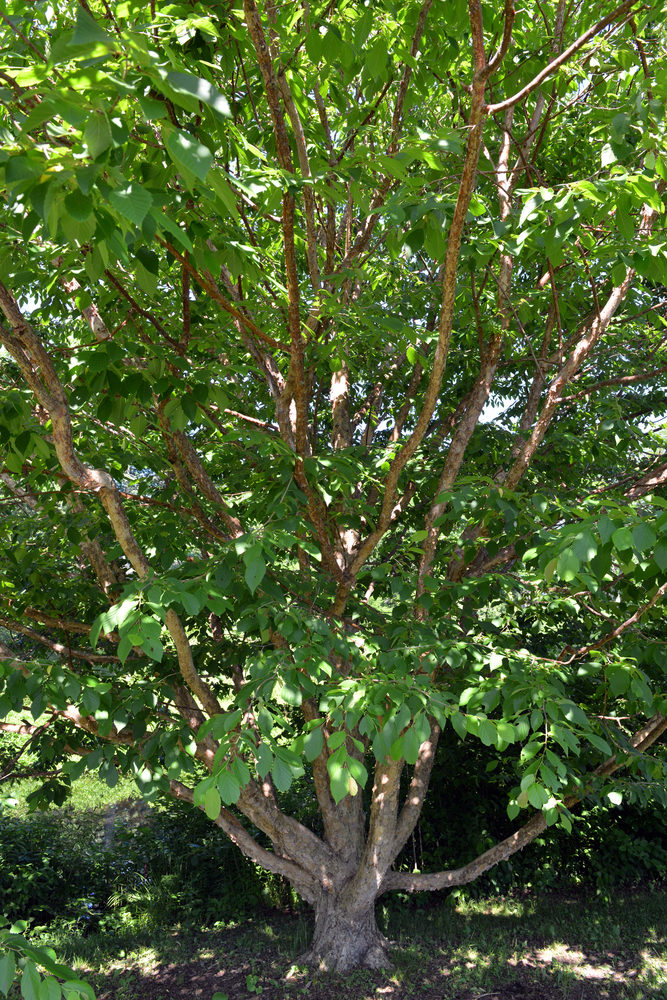
5
Cultivar of Forsythia
Forsythia ‘Meadowlark’
UNIV. OF NORTH DAKOTA
ORIG FROM HAIG DERMEN, ARNOLD ARB.
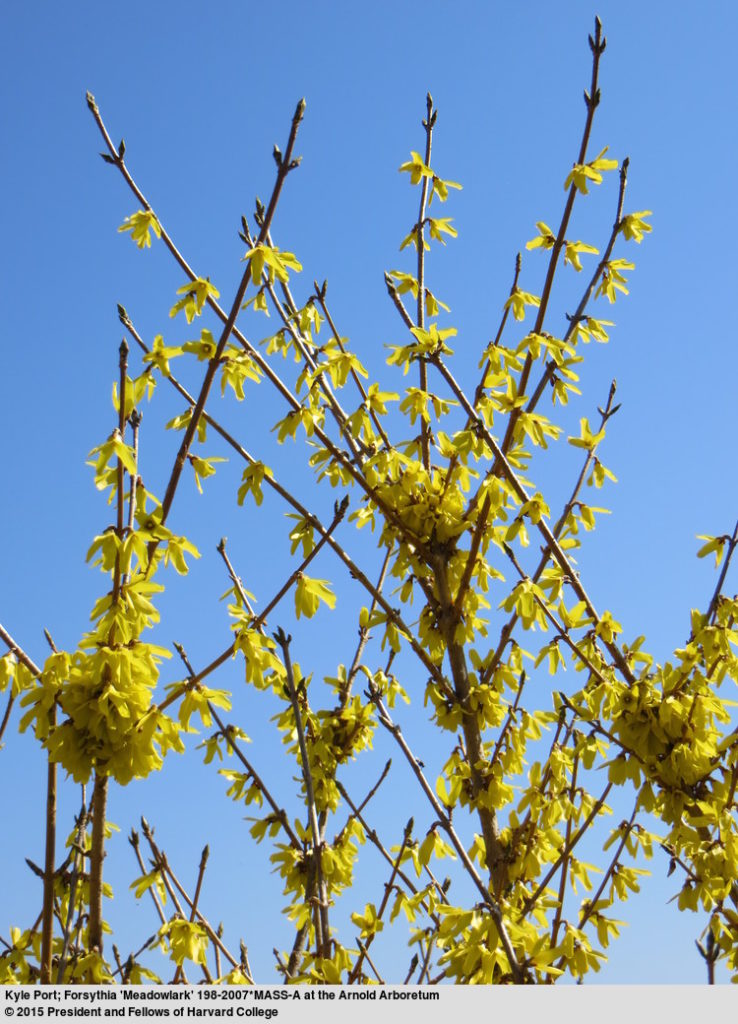
-
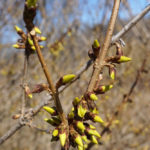
Breaking flower buds. -
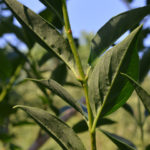
Simple leaves with serrated edges.
Selecting a cultivar sometimes takes many decades.
Cultivated varieties, or cultivars, find their way into gardens for many reasons, like brighter flower color or better growth form. Tolerance to environmental extremes, particularly low temperature, is another important trait. Forsythia ‘Meadowlark’ was introduced in 1984 by the Arnold Arboretum because its flower buds can withstand wickedly frigid temperatures of at least -35F! Harrison Flint (then on staff) discovered the plant’s resilience after the winter of 1966/67, when most other Forsythia blooms in the collection were killed. The plant in question grew near where you stand and was a hybrid crossed by Karl Sax (Harvard Professor and later Arboretum Director) in 1935. It escaped notice and interest until that fateful winter revealed its special value. Interestingly, one of the hybrid’s parents was Forsythia ovata, and had been collected by Ernest Wilson in 1918 from Mt. Kumgang on the Korean Peninsula. Sometimes, it takes not just time, but many people, to introduce a good plant.
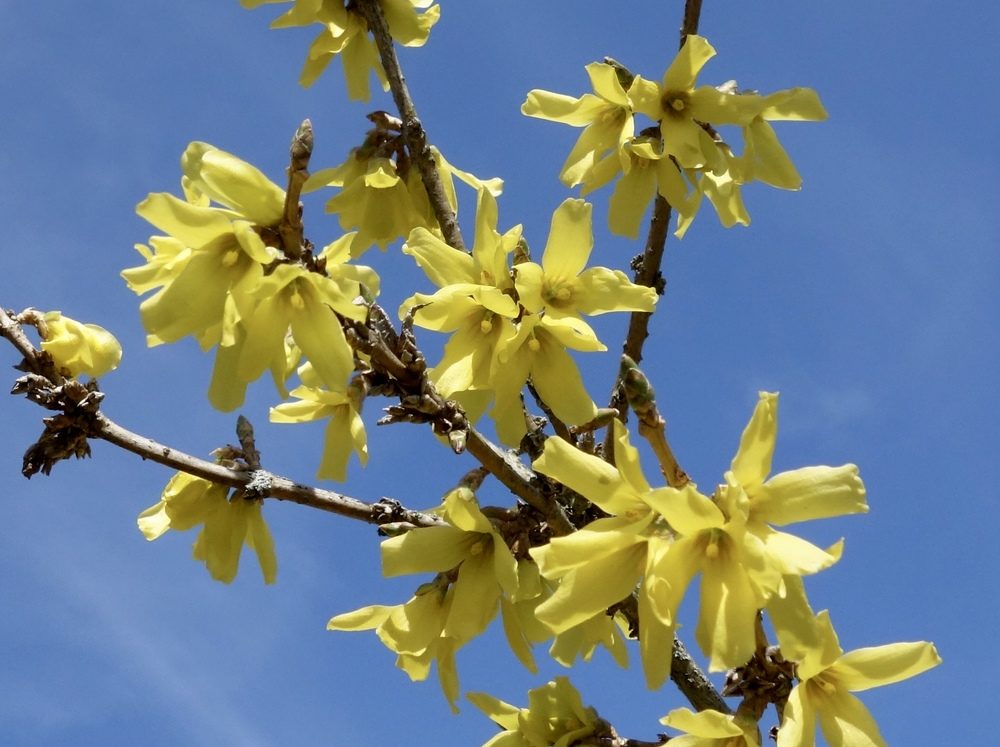
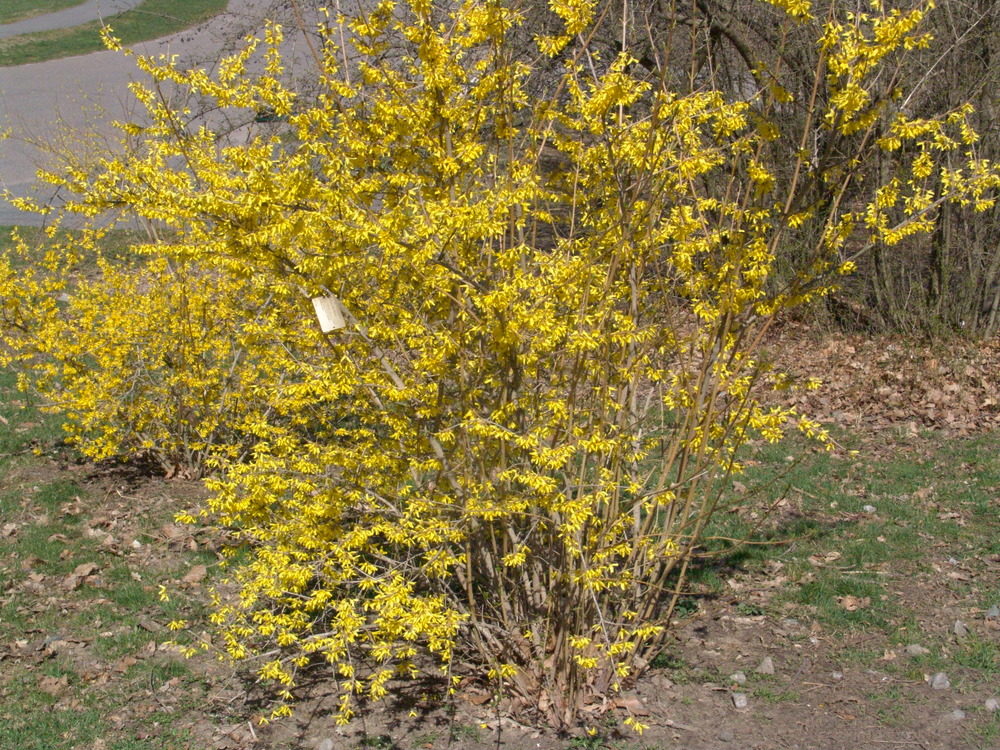
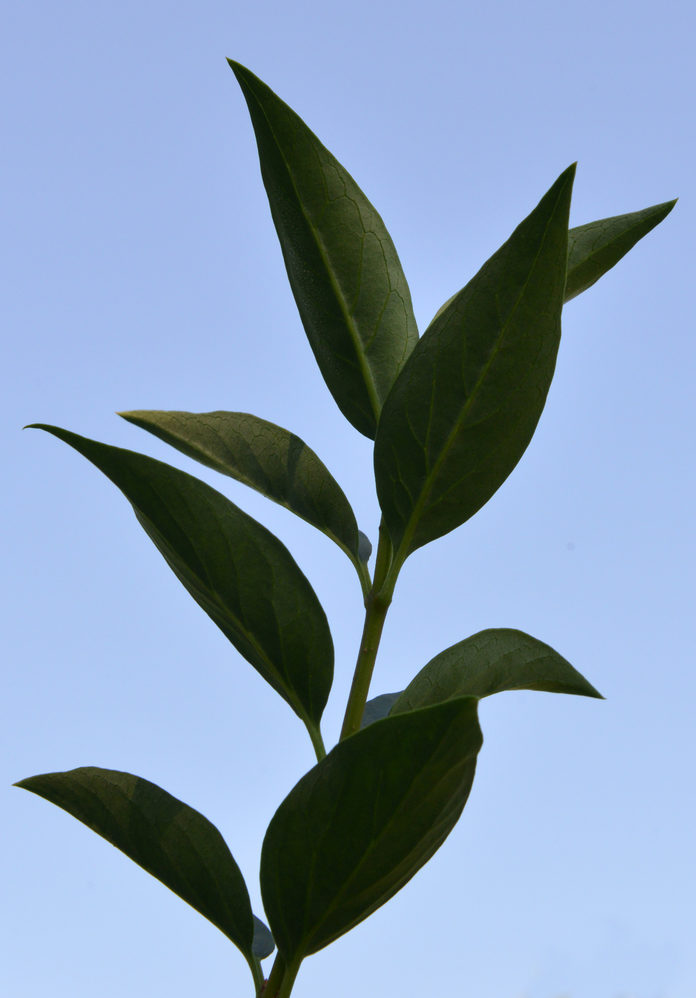
6
White Ash
Fraxinus americana
STATES – DOSMANN, M.
M.S. DOSMANN, ARNOLD ARB.
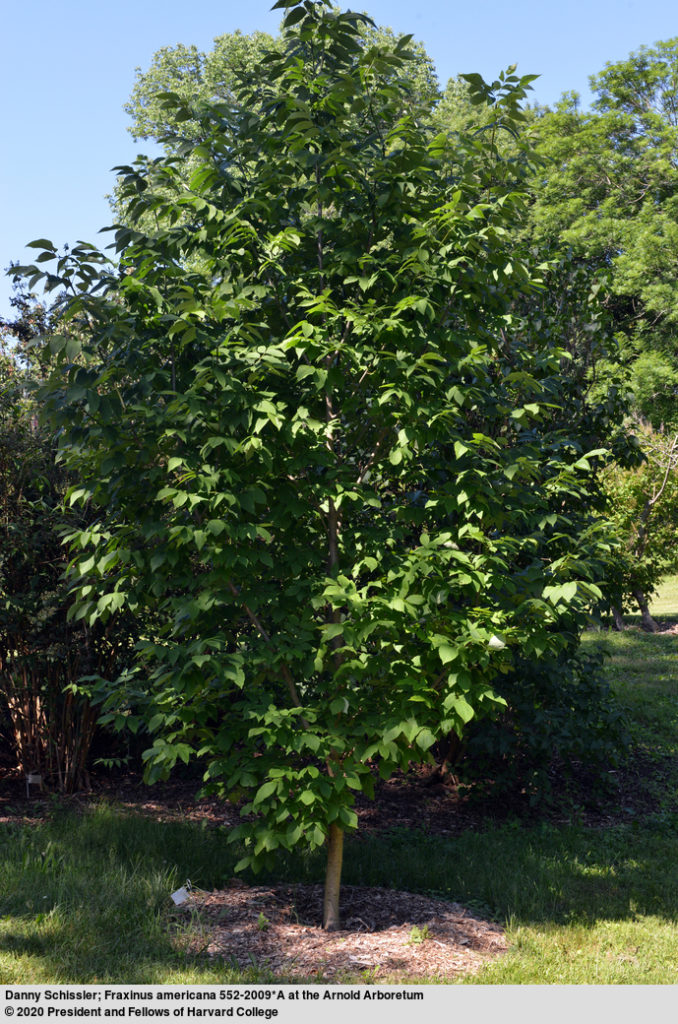
-
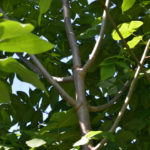
Trunk with opposite branch arrangement. -
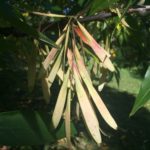
Winged seeds. -
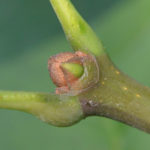
Developing terminal bud.
Introduced insects may threaten our plants, but we intervene to collect before it is too late.
In 2002, emerald ash borer was discovered in Detroit. Since then, this insect from east Asia has spread across much of North America, devasting our native ash trees such that they are now threatened with extinction. In 2014, the borer reached Boston and the Arboretum. Luckily, ash seed can be preserved for decades or longer if kept in cold, dry conditions, and we have collaborated with the USDA to collect and conserve seed from populations before they blink out. The Arboretum also grows and preserves a few individuals of different ash species to be used for study, teaching, and storytelling. I collected the seed that became this American ash tree near the homestead of Vermont Senator Justin Smith Morrill, who authored the Acts of 1862 and 1890 establishing public Land Grant Universities and several Historically Black Colleges and Universities. I wonder if Morrill walked below this young tree’s great-grandmother?
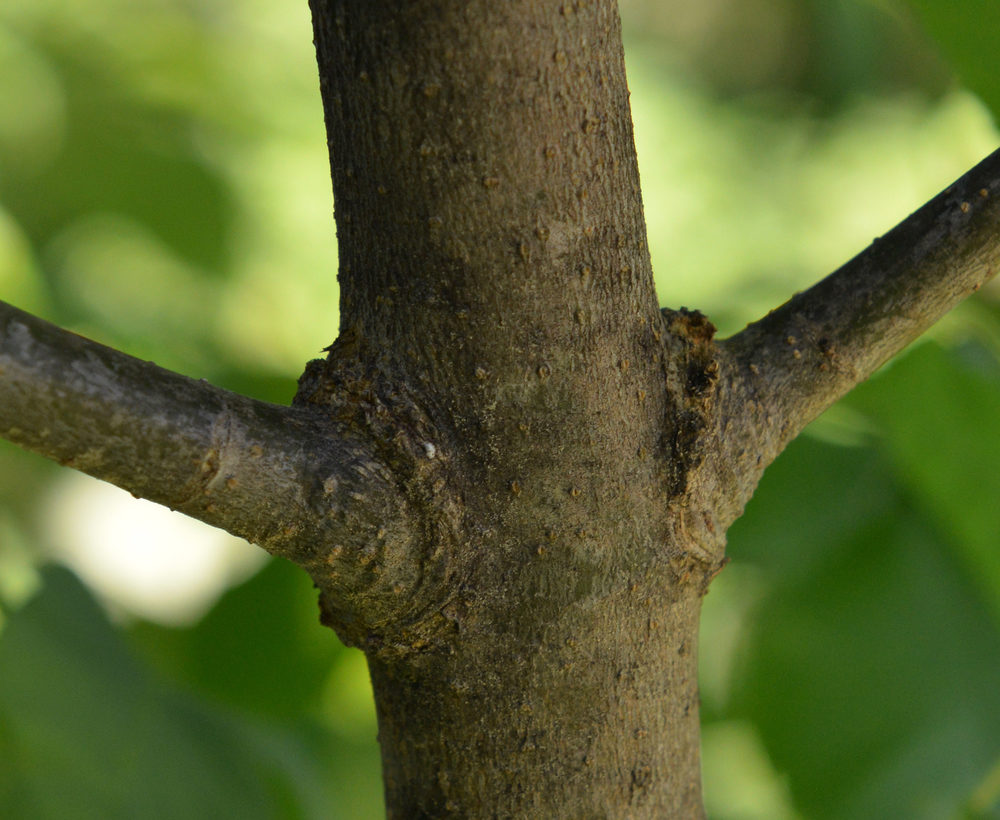
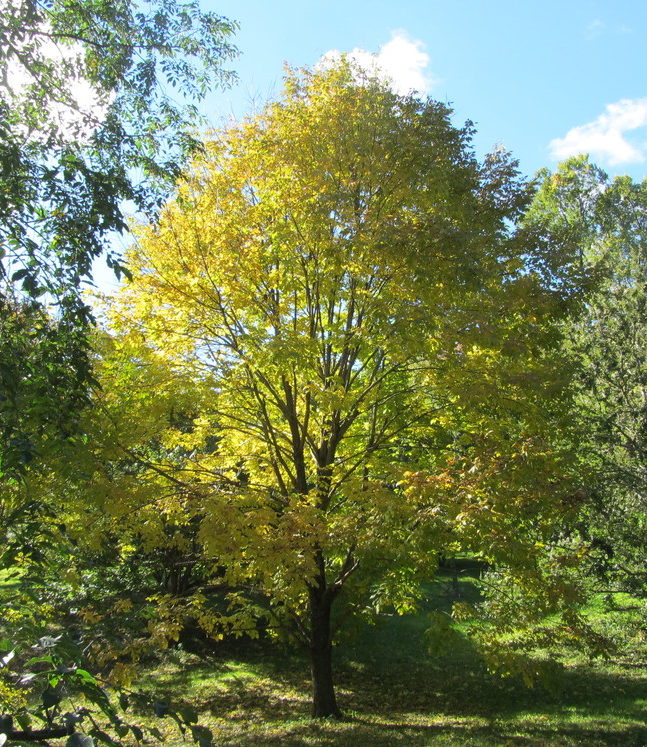
7
Hydrangea longipes
Hydrangea longipes
AIELLO, A. S., DOSMANN, M.,
WANG, K. NACPEC10-013
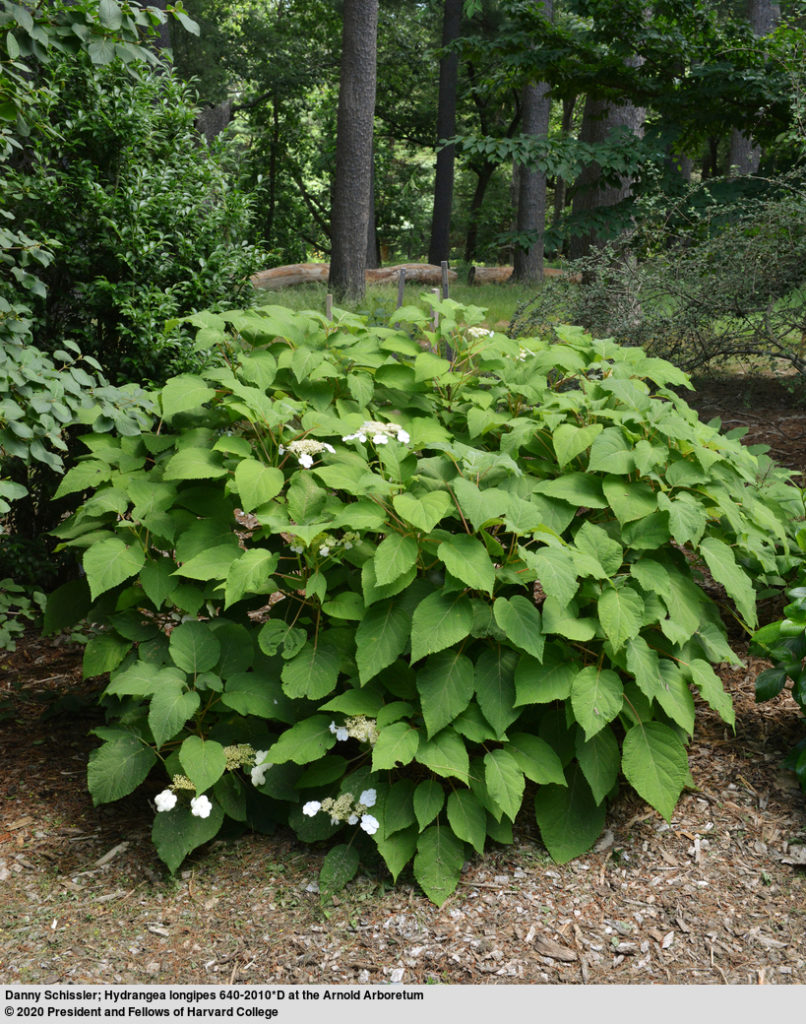
-
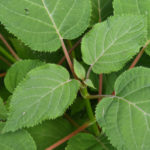
Large leaves in opposite arrangement. -
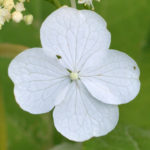
Delicate white sterile florets.
If at first you don’t succeed, keep trying!
Some species grow on the first attempt, others require multiple introductions. That seems the case with Hydrangea longipes, a rarely cultivated, beautiful summer-flowering shrub from central China. For almost a century, we have tried to grow it, but most plants resisted cultivation at an early stage, rarely surviving a few winters. In 2010 colleagues and I collected seed from two populations in Shaanxi Province in the moist understory at about 2000 m (6500 ft) in elevation. Interestingly, colleagues had collected the species just a few years before from the same mountain, but about 500 m (1600 ft) lower in elevation. The earlier plants failed to survive at the Arboretum, but so far plants from our 2010 introduction have. Perhaps our collection, just a bit higher up the mountain, lent them additional cold hardiness. Or maybe it was just luck. Regardless, I’m glad we made the multiple attempts!
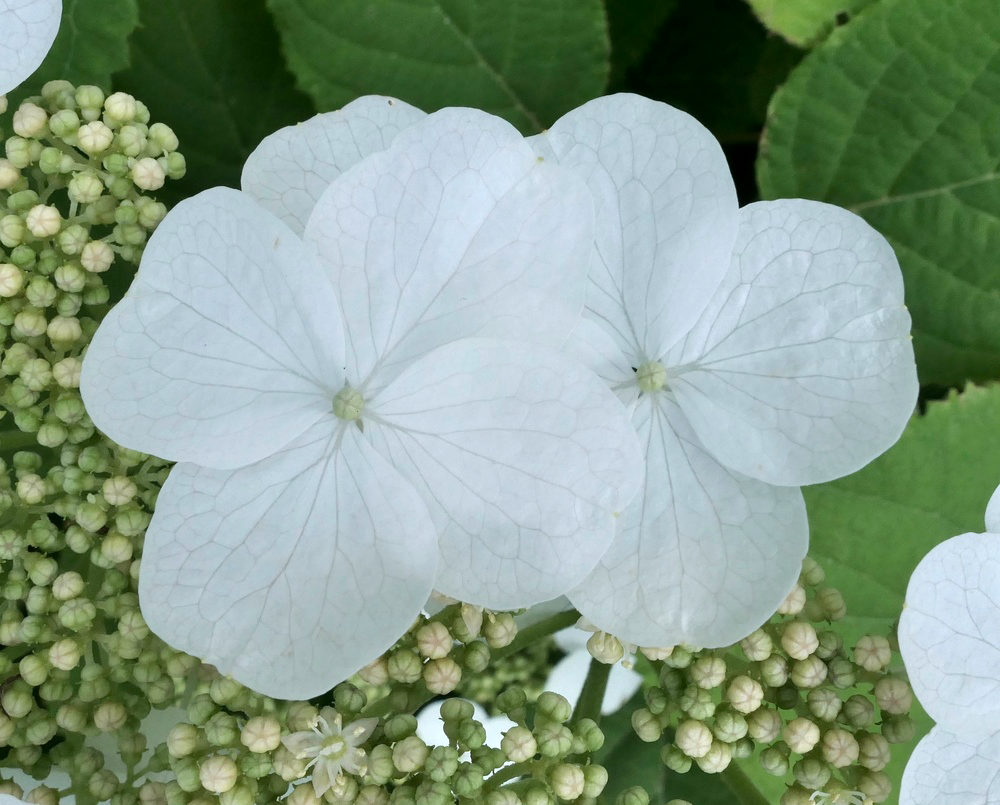
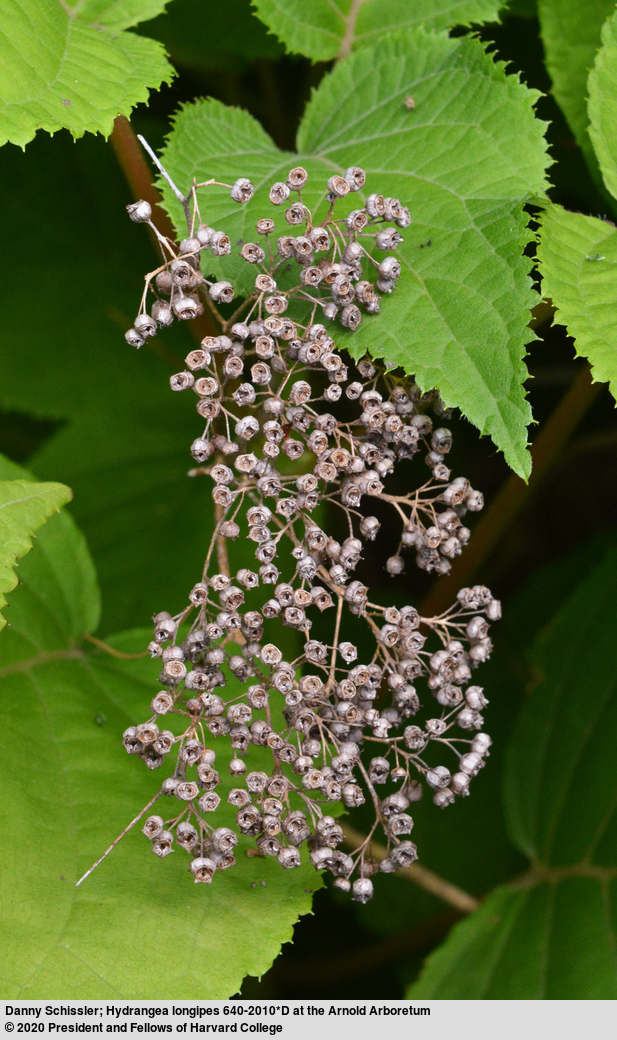
8
Katsura Tree
Cercidiphyllum japonicum
CHINA – DOSMANN, M., GRAVES, W.R.
M.S. DOSMANN, ARNOLD ARB.
ORIG FROM M.S. DOSMANN, IOWA ST.
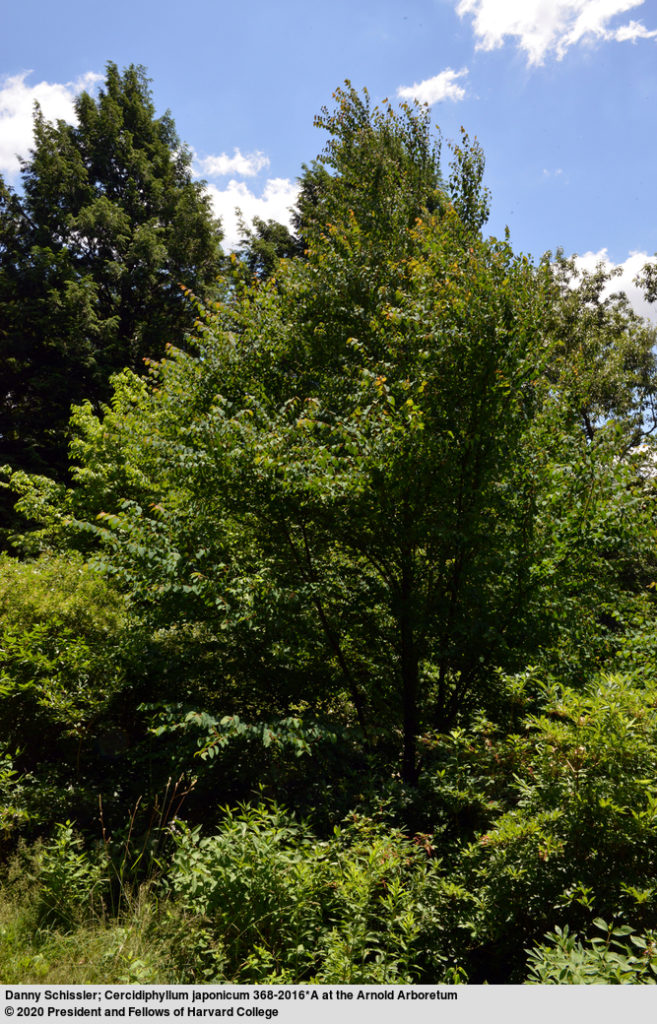
-
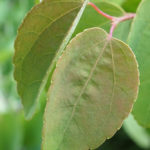
New simple leaves with serrated margin. -
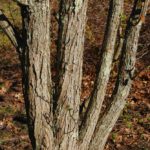
Furrowed mature bark and multipe trunks.
Sometimes it is about the individual plant, and sometimes it is about the grove.
This path is home to a young, small grove of katsura (Cercidiphyllum japonicum), a tree from China and Japan that I have spent over 20 years studying. I find the heart-shaped leaves a treat, emerging reddish in spring, darkening to blue green by summer, and then sparkling a rich tapestry of gold and apricot in autumn. And, just before they drop, those leaves emit the sweet smell of burnt brown sugar. This tree as well as nearby accessions are clones of one I collected in Shaanxi Province on my first expedition to China in 1999; another was collected by colleagues in Gansu Province further west in 2005. In nature, katsura are often found anchoring hillsides, so we have placed them here to replicate their habitat in the wild. In time, I hope the grove will provide an immersive experience and perhaps for a moment, transport visitors to a mountain in central China.
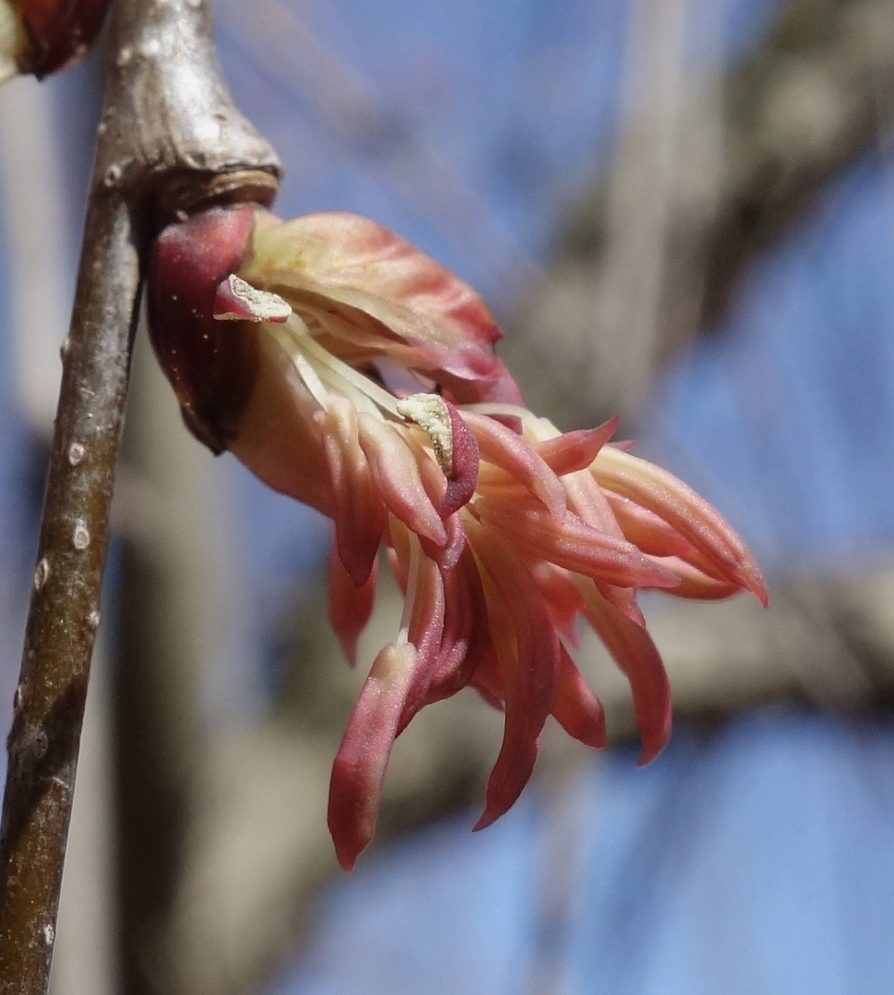
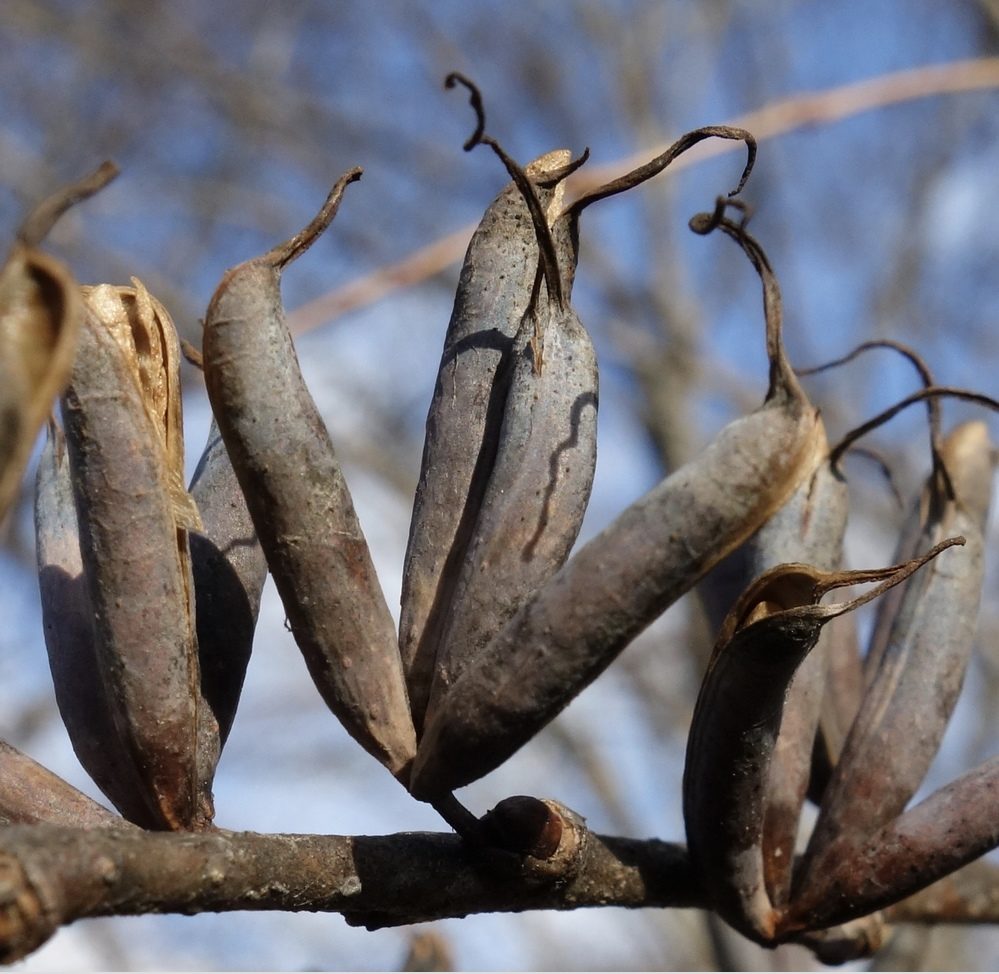
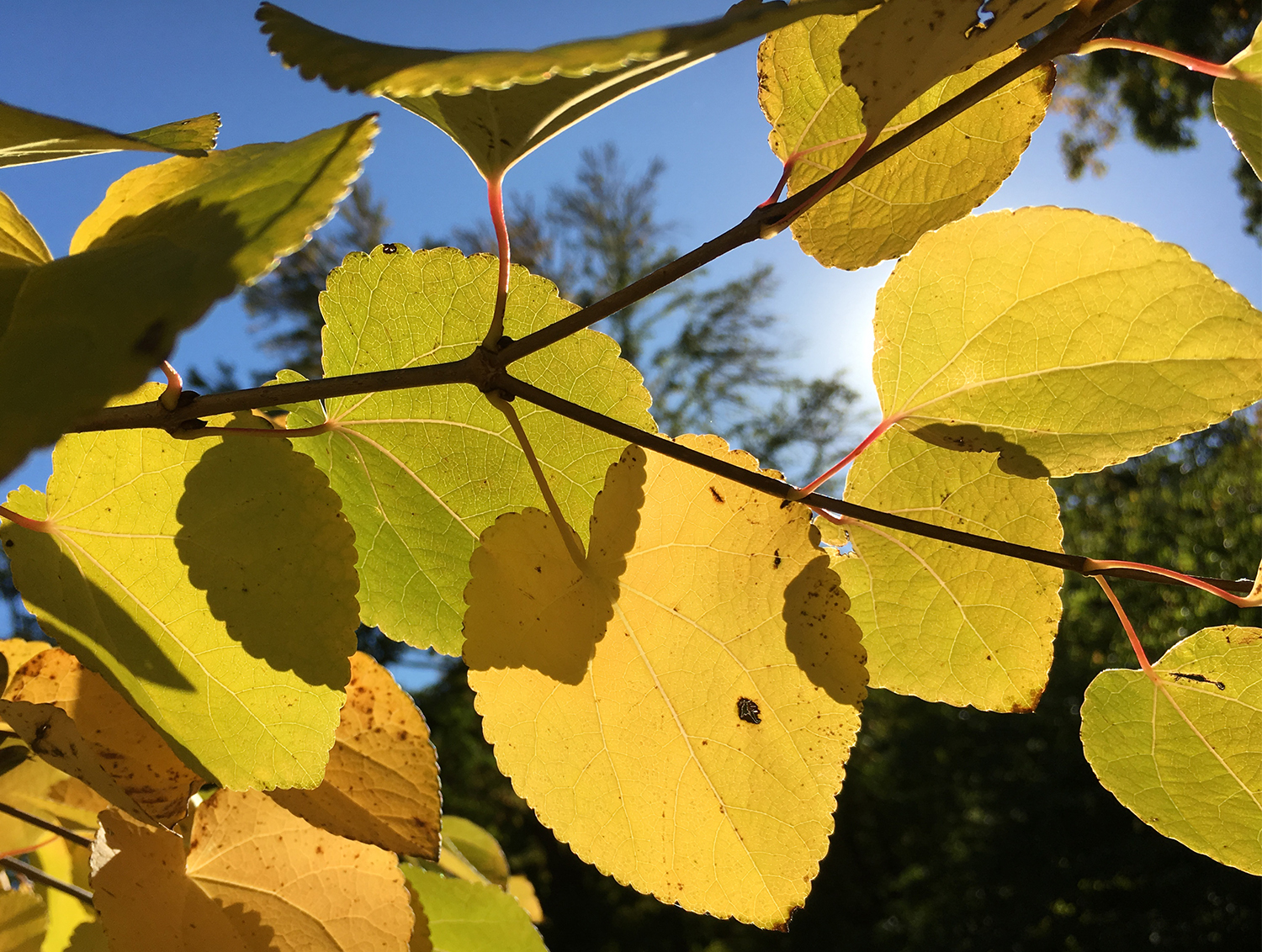
9
White Oak
Quercus alba
LINEAGE 22886 – 1950
U – UNCERTAIN ORIGIN UNKNOWN
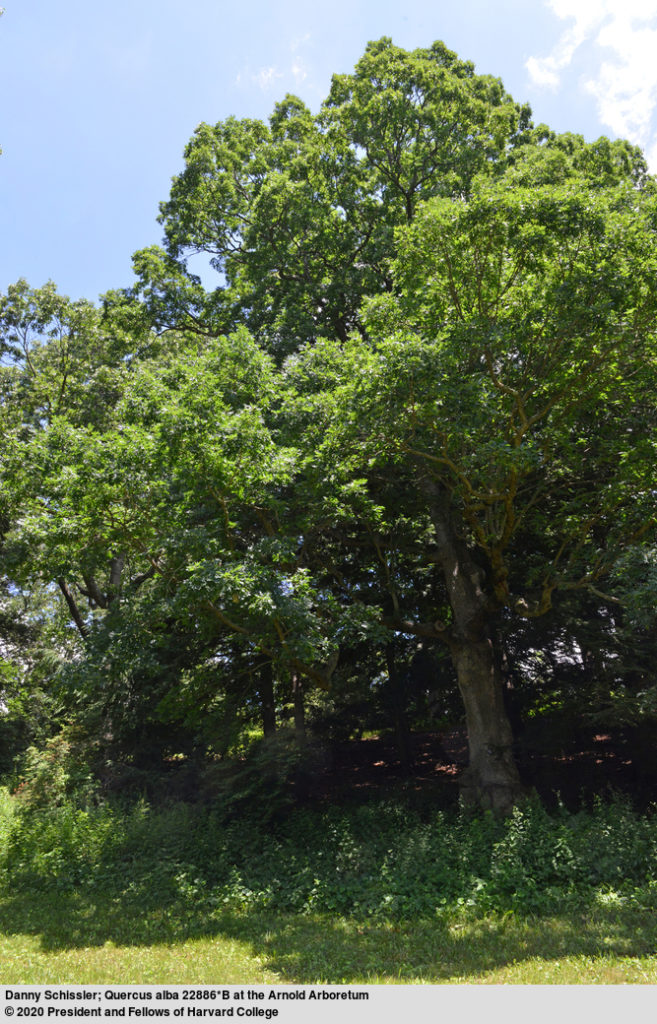
-
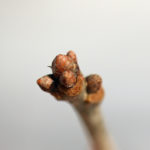
Dormant buds. -
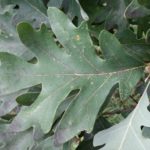
Green lobed leaves. -
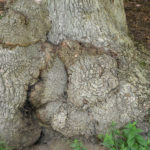
Rough mature bark. -
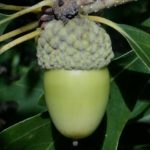
Developing acorn.
A few white oaks have seen it all, and then some.
The Arboretum has changed dramatically since its 1872 founding, when an old farm started to become what you see today. To assemble collections, plant explorers sought seeds from far away lands, while horticulturists scrutinized commercial nurseries for novelties. Some 17,000 plants grow in the collections today, while another 70,000 have come and gone. And as all this transpired, a half-dozen or so white oaks (Quercus alba) like this one watched. These stalwart specimens date to the early 1800s, and are memories of the old fencerows, farm fields, and woodlots of colonial New England. As accessioned plants, they are given expert arboricultural care, digitally mapped and databased, and routinely measured and monitored. In reality, however, the white oaks are the ones doing the monitoring. They have witnessed much in over 200 years, and I wonder just what they will see in the decades and hopefully centuries to come.

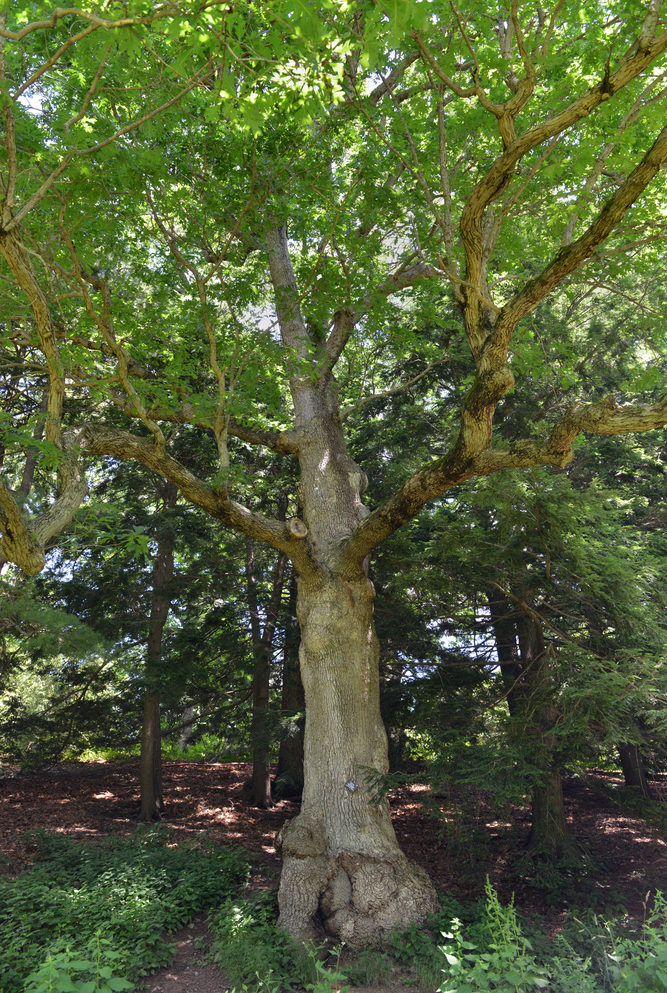
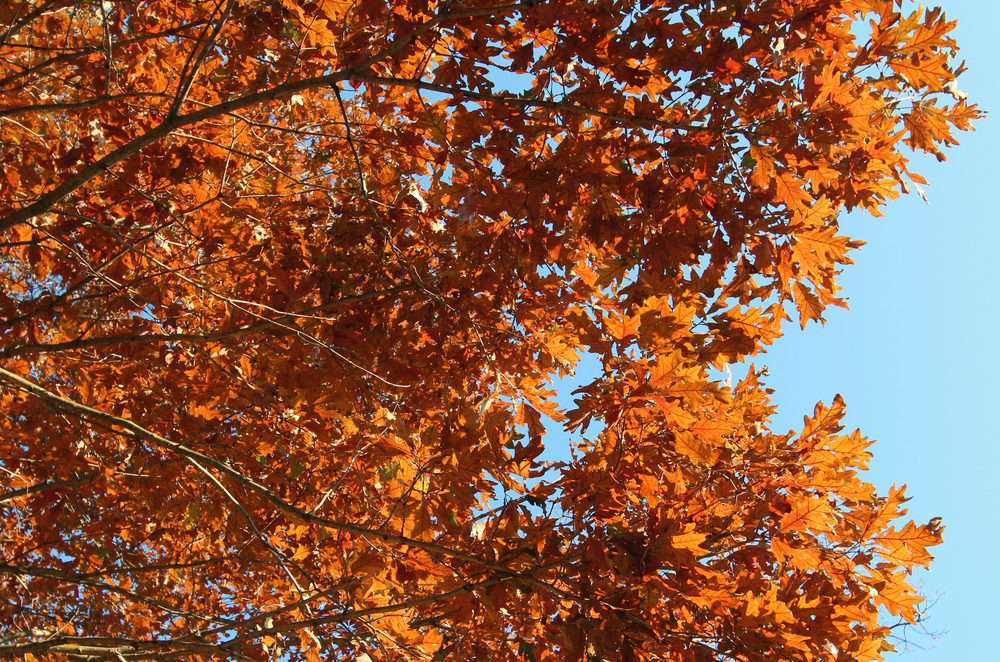
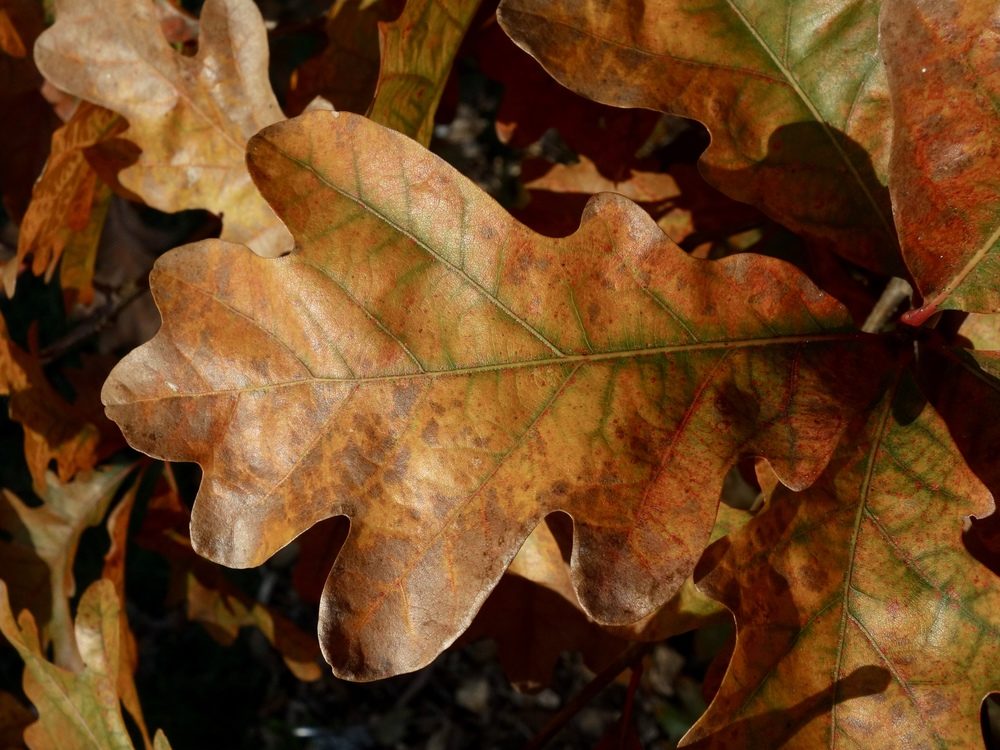
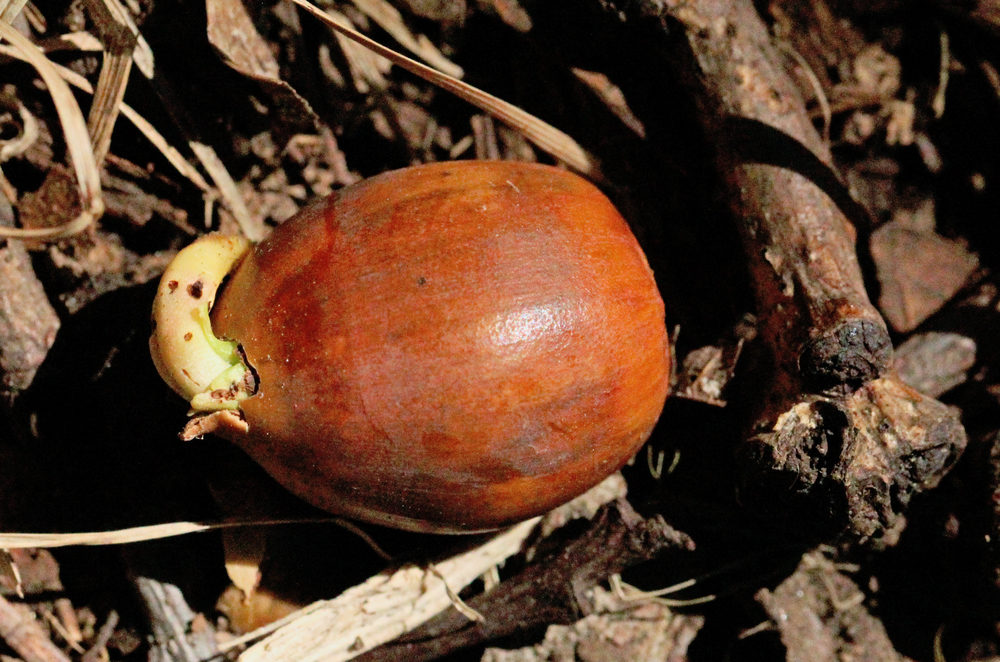
10
Regal Lily
Lilium regale
CHINA – XINFEN GAO
NACPEC17-039
NACPEC 2017
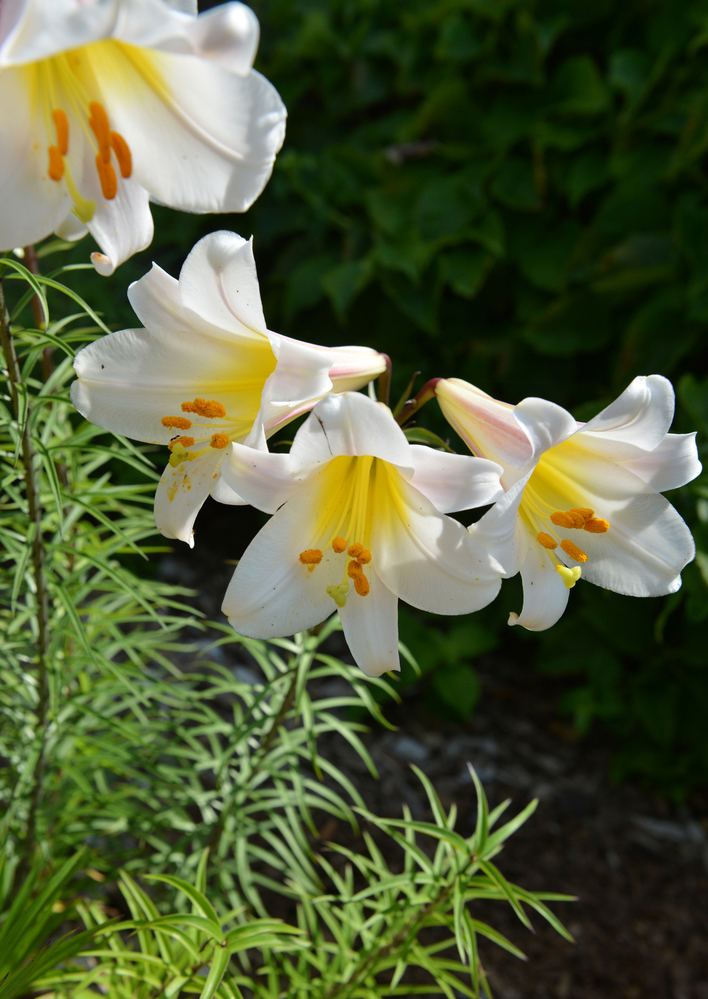
-
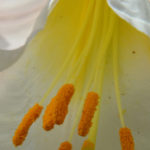
Prominent, pollen-covered anthers surround a stigma. -
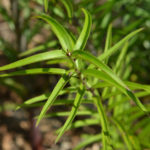
Slender leaves arranged around a stem.
The Arboretum grows woody plants, with the occasional exception…
At the time of its founding, the Arboretum’s original collections policy included herbaceous plants. However, founding director Charles Sargent quickly winnowed the scope to focus upon woody plants. This meant that China’s regal lily (Lilium regale), which Ernest Wilson proudly collected and named, after what proved a nearly life-ending expedition, was not accessioned when introduced in 1911: a lily is not a tree or a shrub, after all. But the species captivated me one June day in 2014 when I saw the ivory-white blooms adorning the cliffs above Sichuan’s Min River. The Arboretum needed plants, and in 2017 we were gifted seeds from Xinfen Gao of the Chengdu Institute of Biology, from plants she collected in the wild. I hope that Wilson’s ghost is pleased by their parade of flowers, and that Sargent’s understands why we planted them.
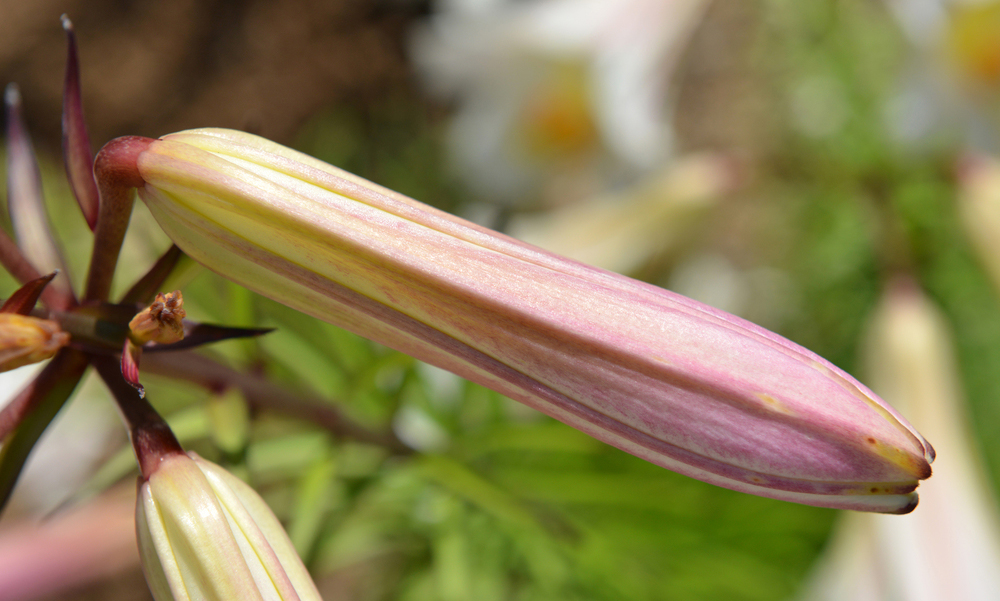
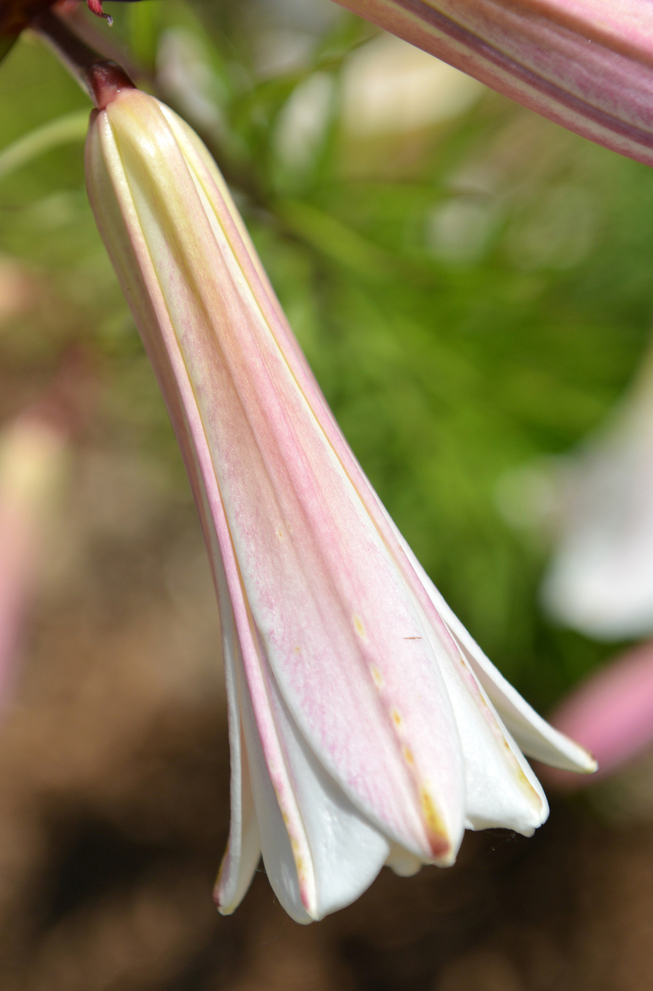
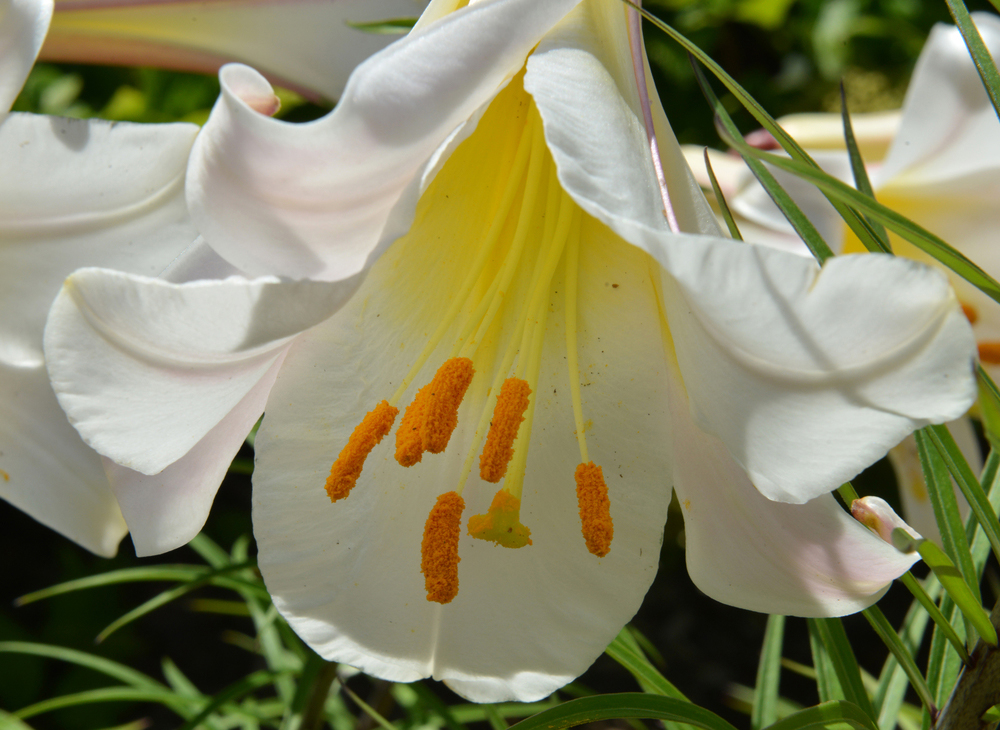
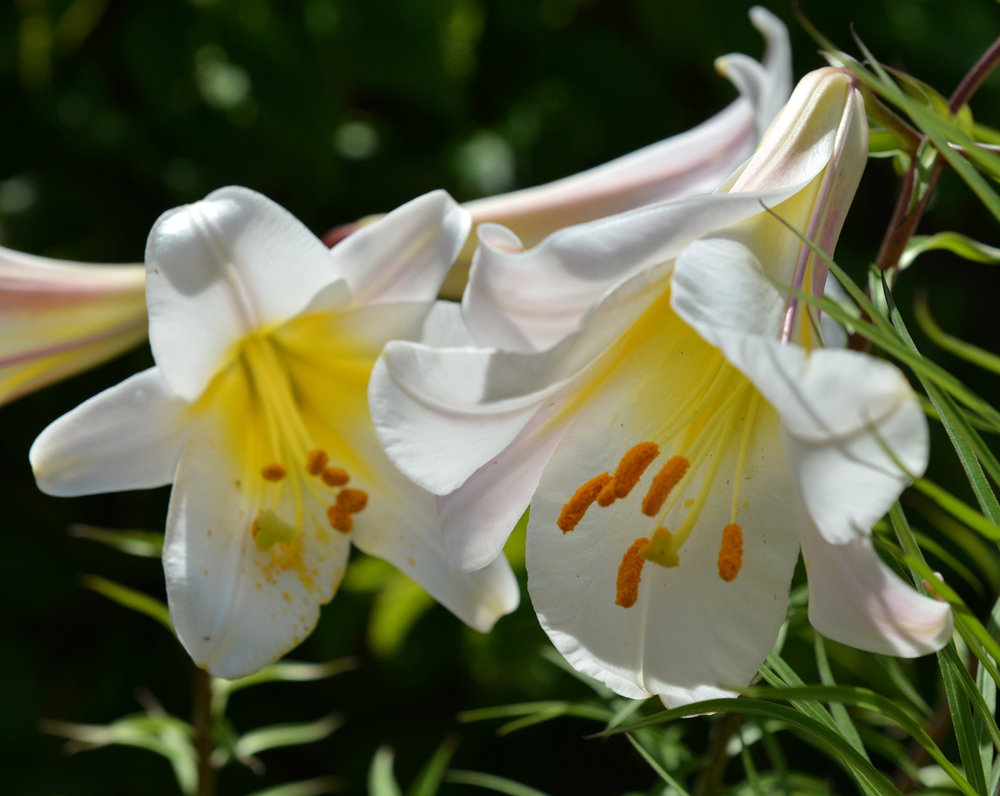
11
Persian Ironwood
Parrotia persica
HARVARD BOT. GDN., MA
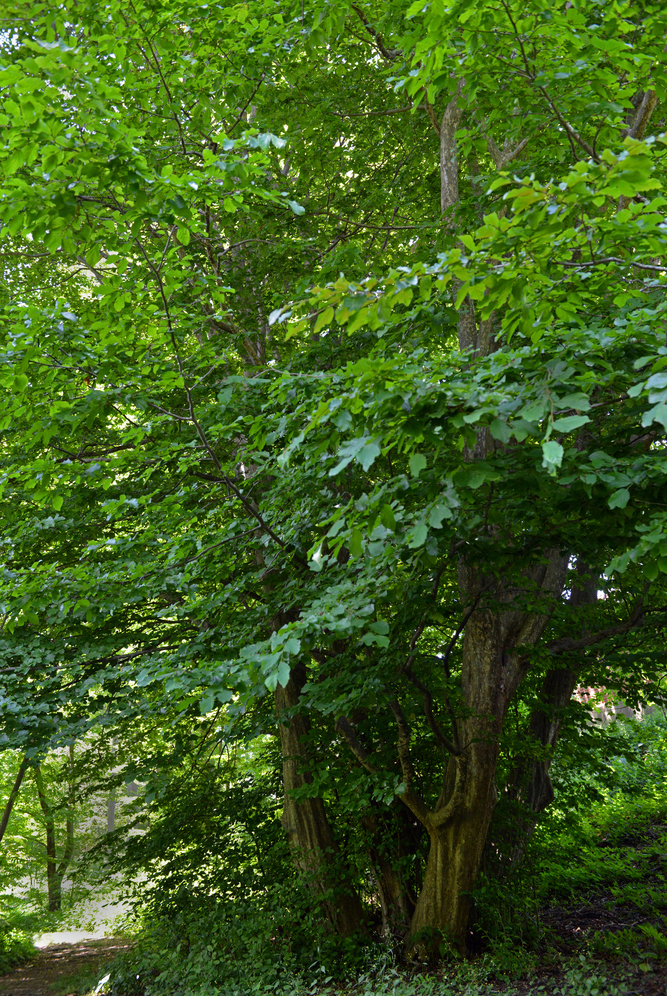
-
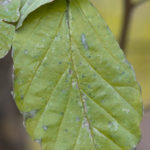
Simple leaves show wavy margins. -
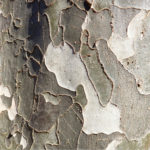
Mottled gray bark. -
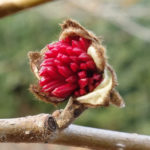
Brilliant red flowers open in late winter.
The gift of a plant is a powerful thing, and that is why we give them.
This Persian ironwood (Parrotia persica) is one of the largest known in cultivation, and is also one of the oldest plants in the Arboretum’s collections. It was a gift from the Harvard Botanic Garden in 1881, arriving in December of that year. Propagator Jackson Dawson coaxed the rootless stems to flourish, and soon thereafter this individual was planted among others in its family. Beyond the size, its mottled bark and striking autumn leaf color always stop me in my tracks. Its source–the University’s now-vanished, on-campus garden–reminds me of the generosity of public gardens in sharing plant material with one another and with scholars. The Arboretum maintains that tradition, providing plant material and plant knowledge to researchers, teachers, and visitors the world over.

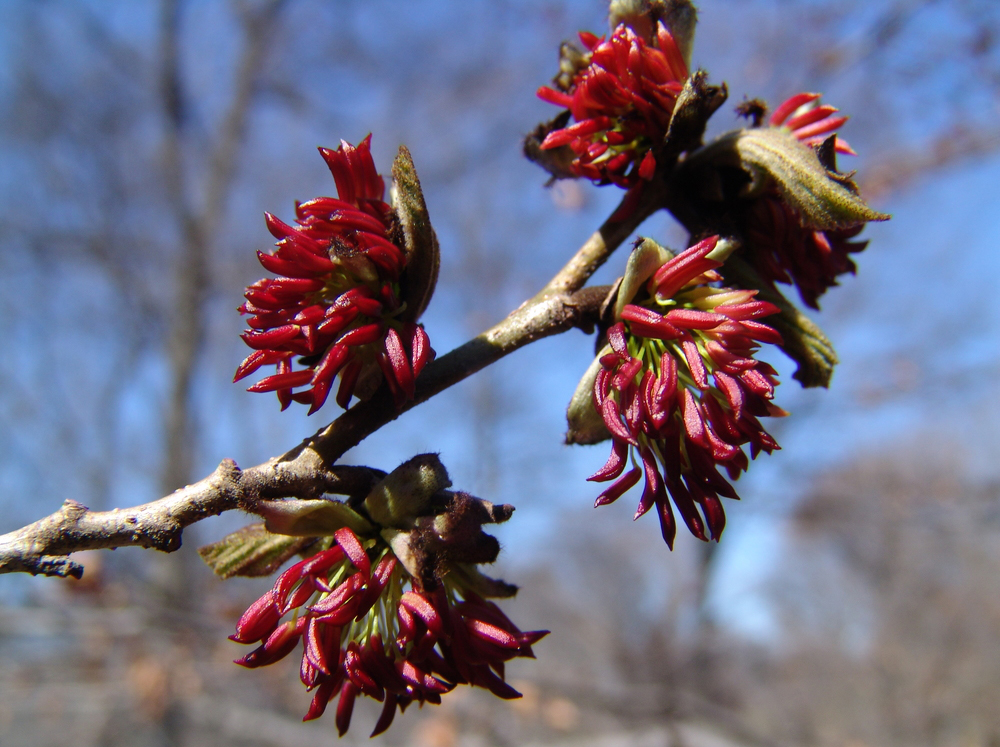
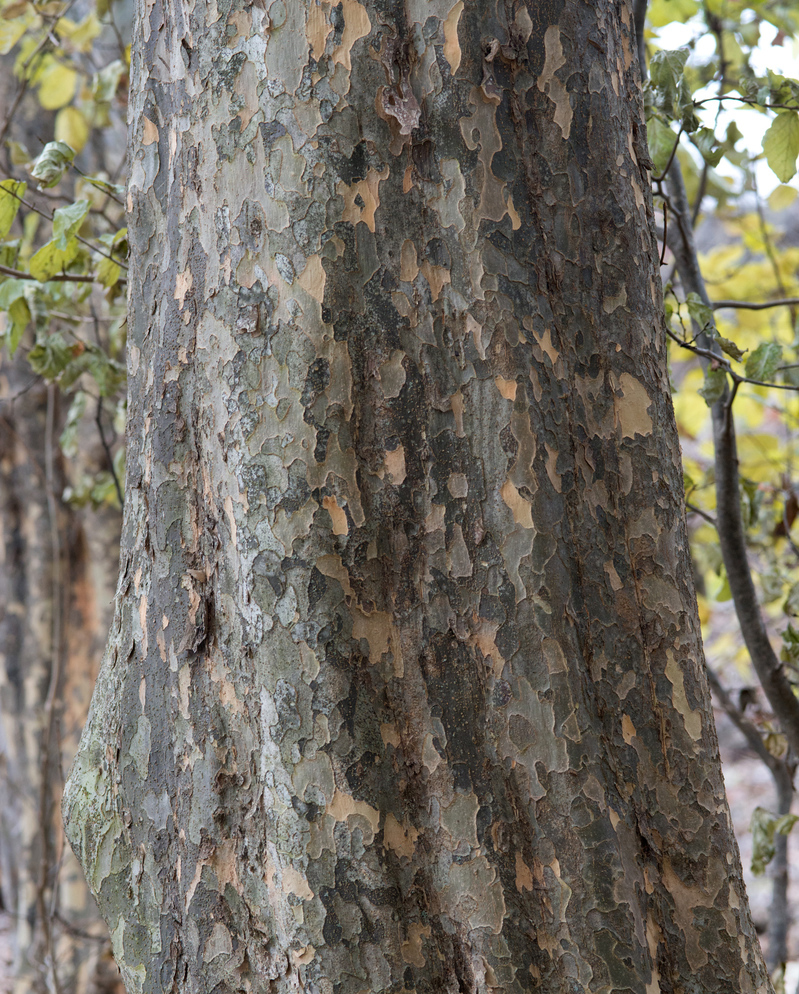
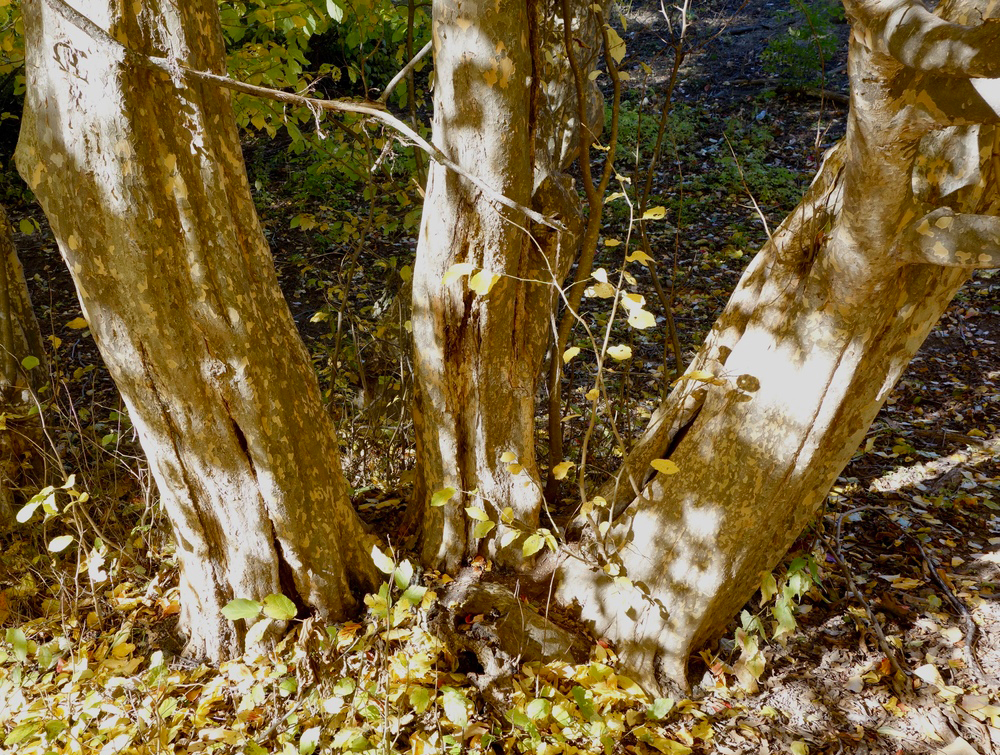
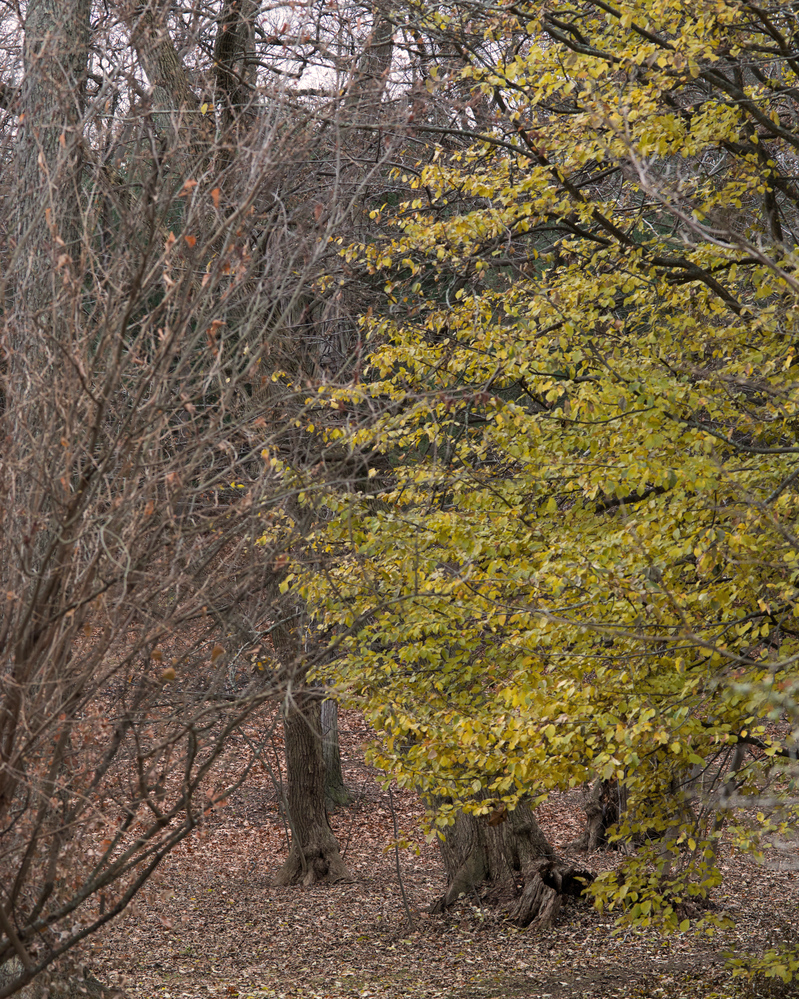
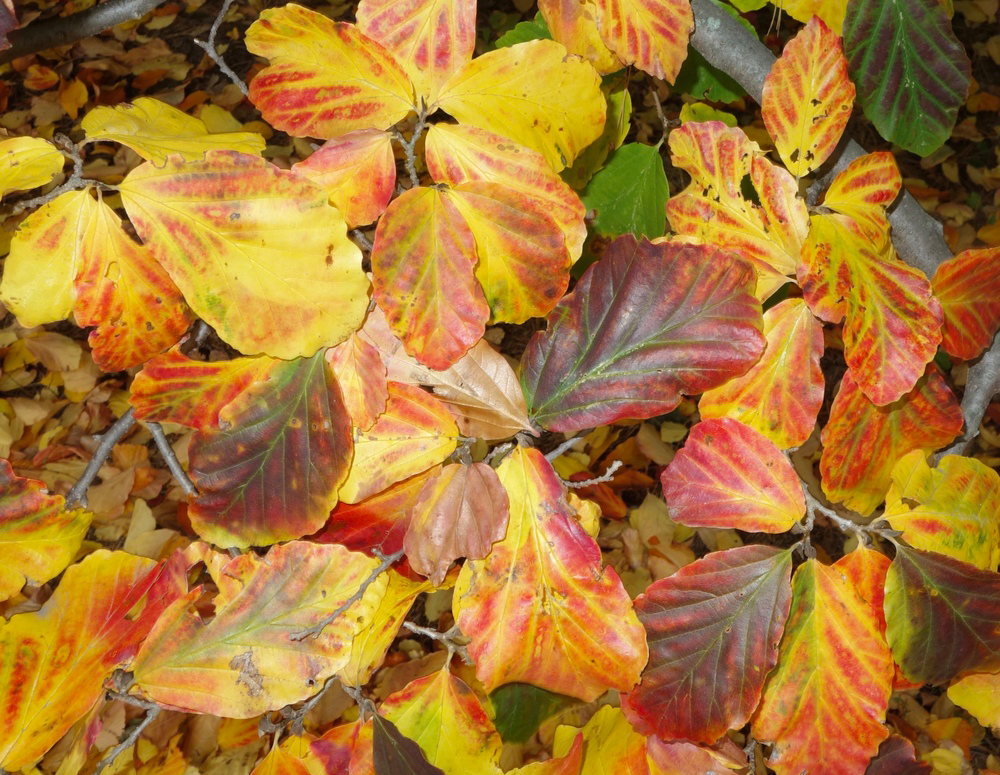
12
Paperbark Maple
Acer griseum
CHINA – WILSON, E. H. 1883
T. A. HAVEMEYER, NY
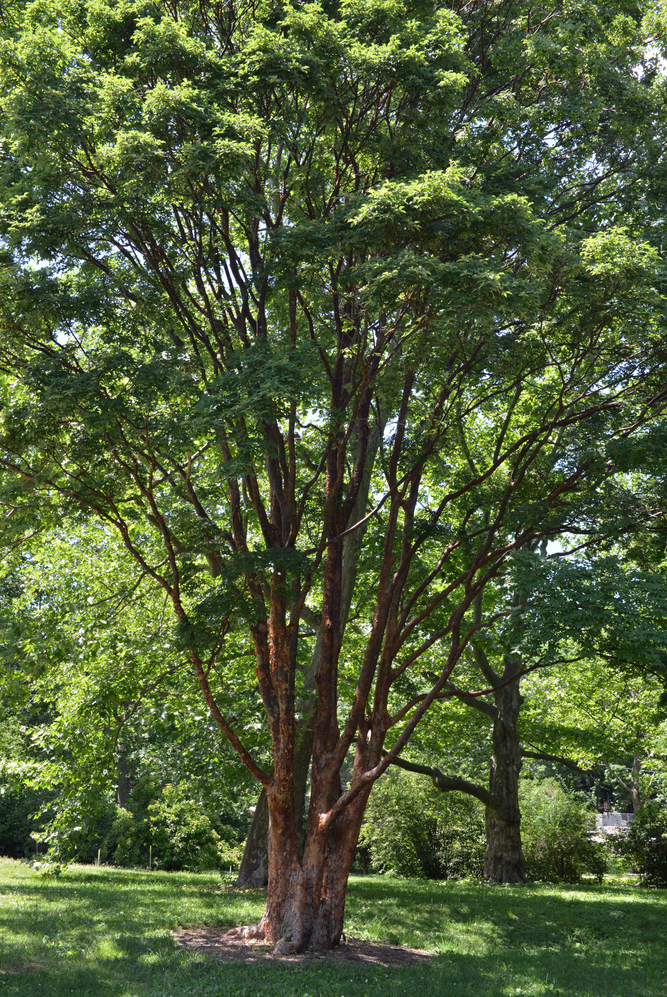
-
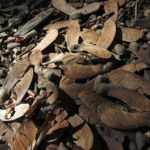
Recently fallen winged seeds (samaras).
A grove to celebrate an endearing, beautiful, and rare tree species.
We began near a young paperbark maple, and end below the canopy of another that arrived in 1925. This tree is a clone of one collected in 1901 in China as seed by Wilson when he worked for Veitch Nursery. He collected this species again–as two seedlings–for the Arboretum in 1907 (you may have passed one of those two trees in the Explorers Garden). Almost a century would pass before it was collected again during a NACPEC expedition in 1994, with Arboretum scientist Peter Del Tredici participating. Over 20% of Earth’s plant species, including this one, are threatened with extinction, and in 2015 I participated on a NACPEC expedition focused entirely on the conservation of this imperiled species. You’ll see a number of young maples planted nearby, and room in the landscape for even more. This grove will eventually contain every lineage known in cultivation, a stark reminder of the threat faced by many species, and the critical role that gardens and arboreta play in their preservation.
